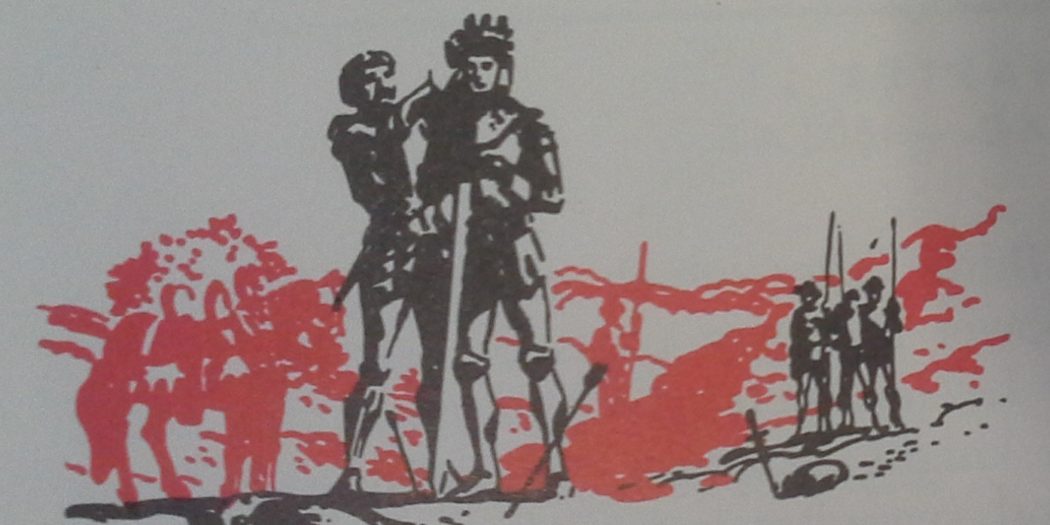Henry Tudor was a patient young man, who waited and watched while civil war raged in England and quarreling lords fought to see who would be king. He waited safely in France, biding his time until his spies told him the hour had come to strike. Then from northern France he crossed the English Channel with 2000 soldiers. Ahead of Henry and his soldiers had gone his agents, who sought to weaken the position of England’s King, Richard III. Henry’s agents had plotted secretly with some of Richard’s supporters, lords who led small armies of their own. That was why when the battle was fought at Bosworth Field, England, in 1485, first one group and then another broke from King Richard’s ranks and joined Henry Tudor’s forces.
Screaming “Treason, treason!” King Richard III hurled himself into the thick of the fray. He wanted to kill young Henry Tudor, but King Richard himself was struck down. As the King’s armour clad body crashed heavily to the ground, the light golden crown that fitted over his helmet rolled under a nearby hawthorn bush. When the battle was over, a soldier picked up the crown and placed it on Henry Tudor’s helmet.

For over a hundred years, Henry Tudor (who became King Henry VII) and his descendants ruled England. There had been kings in England for centuries, but powerful feudal nobles had often refused to accept their authority. Moreover, for 30 years before Henry Tudor’s victory at Bosworth, England had been engaged in a disastrous war between two branches of the royal family. But though Henry Tudor and his descendants met with op position, they steadily increased their powers. As a result, England became a unified and prosperous country.
We learn how strong monarchies, or kingdoms, developed in Europe during the later Middle Ages. It is discovered that strong monarchies grew up in France, Spain and Portugal as well as in England. It is noted that the growth of kingdoms brought about struggles not only between kings and nobles but between kings and the Church. In short, you will find answers to these questions:
1. How did kings extend their authority in early England?
2. How did royal power increase in Tudor England?
3. In what other parts of Europe did strong monarchies develop?
4. What forces destroyed the religious unity of western Europe?

1. How Did Kings Extend Their Authority in Early England?
Conditions in the later Middle Ages favoured the growth of royal power. Three conditions developed in the later Middle Ages which encouraged one man power in many parts of Europe.
1. New methods of warfare aided kings. A knight in armour, mounted on a horse and swinging a sword or battle ax, was a match for several foot soldiers. New weapons were developed in the 1300’s and 1400’s which robbed the medieval knight of his advantage on the field of battle. An arrow, shot from an English longbow by a skillful archer, could pierce a knight’s armour at a distance of more than 200 feet. Even more deadly were the effects of gunpowder. Foot soldiers armed with guns could strike down the most heavily armoured knight, while cannon balls could smash gaping holes in castle walls.
Cannon, guns and gunpowder were expensive, few nobles could afford them but the ruler who was rich enough to acquire these new weapons and to hire soldiers to use them could overpower his rivals. He did not have to ask his vassals for men to help him win wars. He did not have to depend on the doubtful loyalty of jealous lords. His weapons and his wealth gave him strength to force his enemies to do as he wished. So the king became stronger than the nobles.
2. Townsmen willingly supported the man who could preserve law and order. Wearied by the endless fighting among powerful lords, the common people concluded they would be better off under one supreme ruler who could enforce order. Even if he were a tyrant, it was better to have one tyrant than a hundred; better to have one set of laws, even if they were harsh, than no law at all. The kings, on their part, soon found that businessmen in general were more dependable than nobles. They could supply the money that kings needed and understood the day to day routine of government. Educated clergymen often proved more skillful than noblemen in handling problems of foreign policy. Clergymen frequently succeeded in bringing about alliances and treaties and in arranging marriages between members of different ruling families.
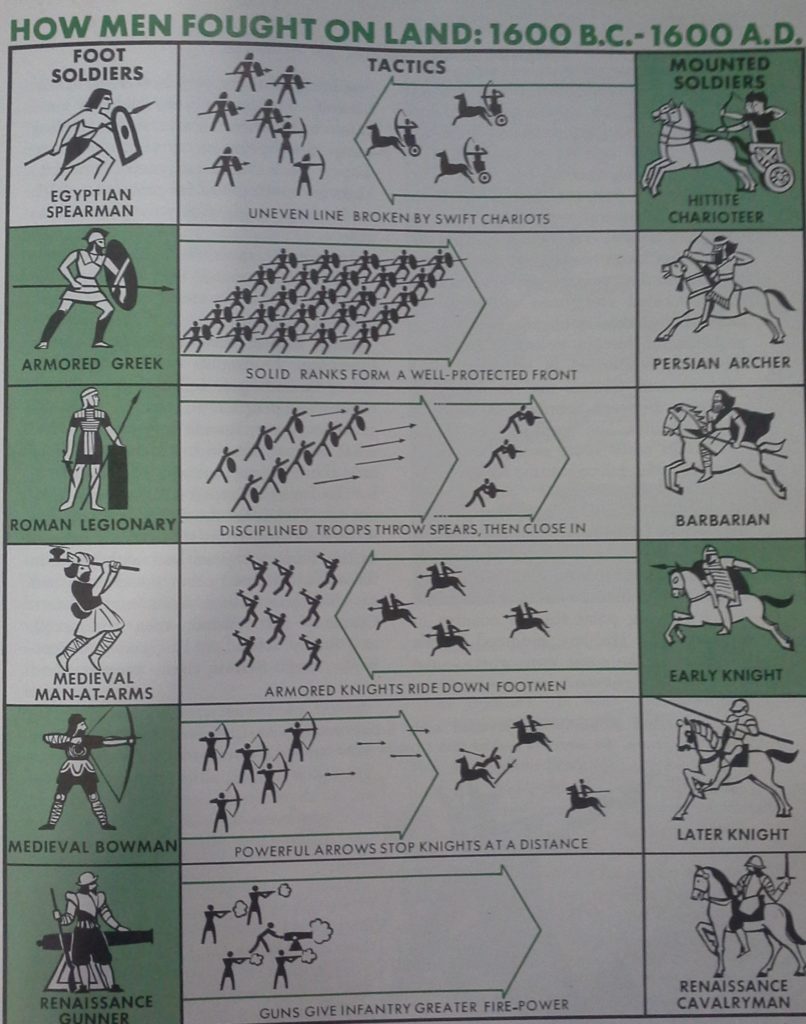
3. Kings made unity possible. One of the evils of feudalism was the lack of unity which it brought about. Nobles were chiefly interested in increasing their own Wealth and power and even the growing towns were concerned with keeping or expanding their own local liberties. A king, however, was a symbol of unity. He was a rallying point for the country in time of war. His law, enforced by his judges, was the same everywhere — not law interpreted by each nobleman to suit himself. The kings coins had the same value everywhere. Later, when trading companies began to carry commerce to distant lands, these companies turned to kings for charters and for protection which no town or noble was strong enough to give.
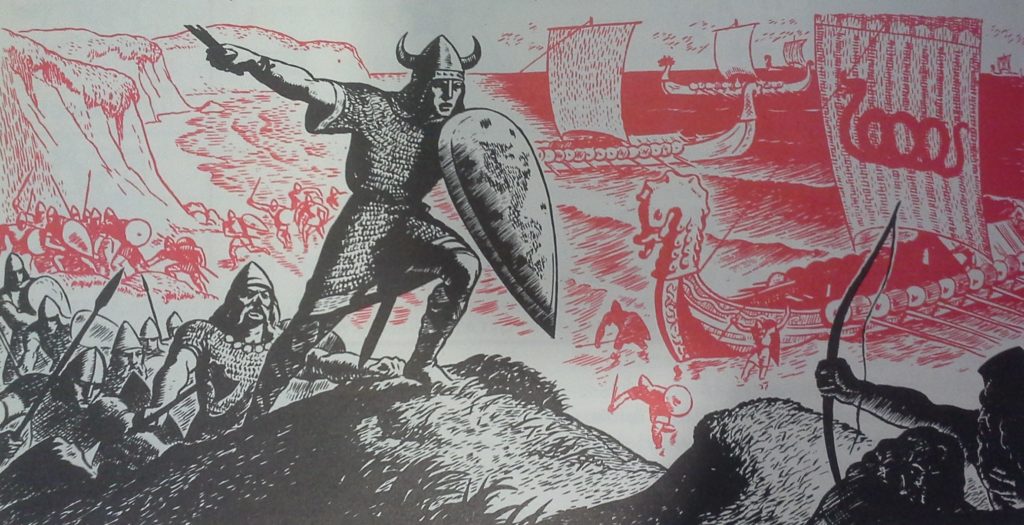
In spite of these favourable conditions, royal power was not easily nor speedily established. Let us see first how it developed in England.
Early English history was a story of invasions. During its early history Britain again and again fell under the control of invading peoples. In the days of Rome’s greatest power, Roman legions controlled what is now England. In northern England there are still remains of a wall built by the Roman Emperor Hadrian to keep out the Picts and the Scots — tribes that were attacking from the north. As soon as the Roman legions had withdrawn in the 400’s, however, other invaders rushed in. Teutonic tribes from northwestern Germany first raided, then conquered and finally settled in England and Scotland. Anglo-Saxons these peoples were called, because the two main invading tribes were the Angles and the Saxons. The Anglo-Saxons soon became Christians through the efforts of missionaries from Ireland and from Rome itself.
The Anglo-Saxons established several small kingdoms in England. Then invaders from Denmark overran the island until late in the 800’s, when they were halted by Alfred the Great, a brave Saxon king. Alfred helped to educate his people by translating foreign books into Anglo-Saxon and starting a year by year history of England. Under Alfred’s descendants England was united into one country. In 1066 came another wave of invaders to England’s shores. These were the Normans, descendants of Northmen who had raided and then settled northern France many years earlier. Led by William, the bold and ruthless Duke of Normandy, the invading Normans won a smashing victory at the Battle of Hastings. The Normans were Christians, spoke French and had adopted many French ways. Their Norman French language soon blended with Anglo-Saxon to make the beginnings of the present day English language.
The Norman victory weakened feudalism in England. William of Normandy was determined to control England. He deprived many hostile Saxon nobles of their estates and gave these lands to his loyal followers. All landowners had to promise that they would be faithful to the king and so became his direct vassals. This change made it difficult for any feudal lord to obtain great power or to build up an army of his own. Moreover, William saw to it that the manors of each great lord were scattered in different parts of the country.
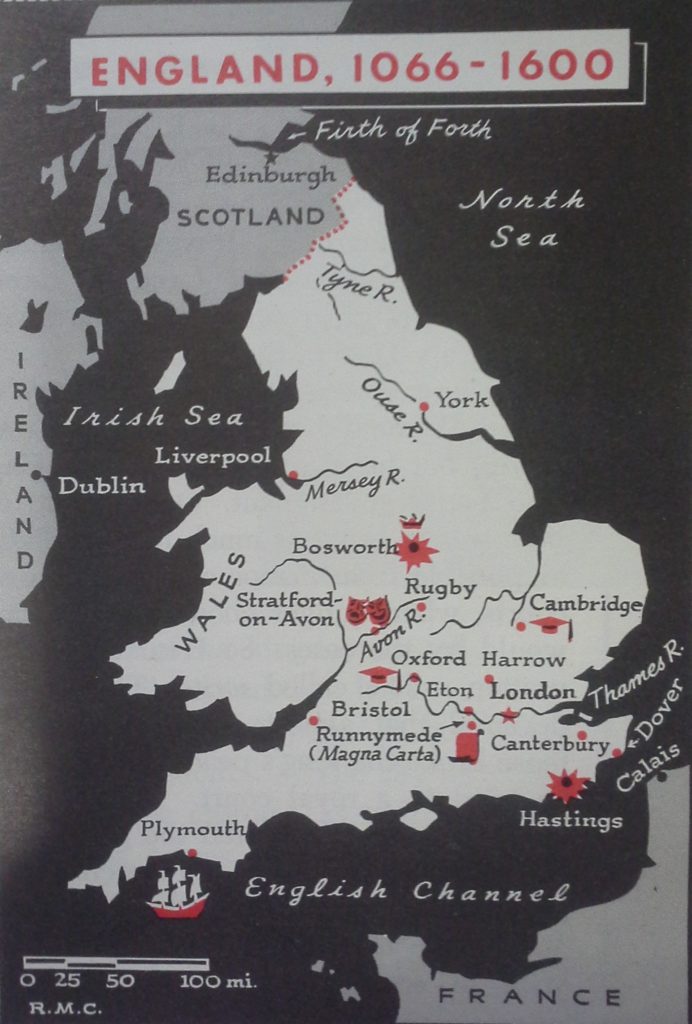
William also ordered a census to find out how many people, cows, sheep, pigs; and how much land each manor contained. William’s officials recorded these facts in the Domesday Book as the report was called.
This remarkable book told the king what taxes he could demand of each manor. By mercilessly crushing attempts at rebellion William gave England peace, though at first it was the peace of fear and despair. At his death feudalism still existed in England, but the king had established royal power over the country.
Henry II strengthened English government and law. About a hundred years after William’s time England was ruled by another remarkable king, Henry II. This tireless monarch, with legs bowed by a lifetime of riding horses, was a familiar figure throughout England. Henry II was more than king of England. As vassal to the French king, he was lord of vast territories in France as well. These territories included not only Normandy but other regions which he acquired by inheritance or marriage. It was as a builder of the English government and law rather than for his great possessions, however, that Henry II is justly famous.
The jury system grew under Henry II. Henry II wanted to strengthen his own power, but he also wanted to give England better government. One way to do both was to bring as much legal business as possible from manor courts into royal courts, where judges chosen by the king would try the cases. So Henry II issued written orders called writs. These writs declared that almost any important offense broke the king’s peace and so must be tried in a royal court. To aid royal judges, Henry II followed the practice of calling together a jury of respected men in each region. The members of these juries were to tell the judges what they knew of wrongdoing in their communities. The old law by which this system was set up reads in part as follows:
. . . the aforesaid King Henry, with the consent of all his barons, for the preservation of peace and the keeping of justice, has enacted [ruled] that inquiry be made through the several counties . . . by twelve of the more legal men of the [district] . . . upon their oath that they will tell the truth, whether there is in their manor any man who has been accused or publicly suspected of . . . being a robber, or murderer, or thief, or being a receiver of robbers, or murderers, or thieves, since the lord king has been king.
Today, so-called grand juries in the United States serve in much the same way. The grand jury investigates the facts to decide whether there is sufficient evidence of wrongdoing to call for a trial.
Trial by combat and ordeal gradually disappeared. Although juries reported crimes in England in the 1100’s, the trial of the accused person was still conducted, according to the old custom, by ordeal or combat. Trial by ordeal meant that the person being tried would have to carry a piece of hot iron or perhaps dip his arm into boiling water. If the person’s burns healed quickly, he was supposed to be innocent of the offense with which he had been charged. In trial by combat, the accused and the accuser fought each other on the theory that God would give victory to the person in the right. Such methods of proof were beginning to go out of use in Henry II’s time. Henry ordered juries to decide certain disputes over ownership of land. In time, trial by jury came into use in England in cases where persons were charged with crimes.
King John brought troubled times to England. Henry II did not succeed in all the reforms of English law that he desired. When he tried to bring clergymen accused of wrongdoing into his royal courts for trial, the Church refused and Henry had to agree that they be tried only in Church courts. Unhappily, too, Henry II’s reforms were not continued after his death. King John, Henry’s youngest son, was treacherous and cruel. He tried to overthrow his father and this attempt by his favorite son hastened Henry’s death. John also plotted against his older brother, Richard the Lion Hearted. After Richard was killed while storming a castle in France, John cleared the way to become king of England by murdering Arthur, son of an older brother and therefore in line for the throne.
Soon after becoming king, John quarreled with the Church. The Pope answered by ordering all of England’s churches closed. This action of course meant there would be no church services of any kind. It meant trouble for King John, for the people might revolt. So John gave in. He announced that the Pope was his overlord and that England was a great fief that King John held as a vassal of the Church.
King John’s misuse of power resulted in the granting of Magna Carta. King John continued to misgovern and oppress Englishmen. As a result, he made many enemies. The clergy opposed him, as did the barons, or English noblemen. Leading citizens of the larger towns and cities also joined in a movement to force King John to meet certain demands. A band of angry barons faced him at Runnymede on the Thames River on a sunny day in 1215. King John, of course, did not want to give up any of his power. “Why do they not ask me for my kingdom?” he shouted in his anger, but the King’s advisers urged him to agree to the demands of the nobles, clergy and townsmen. King John realized he was helpless in the face of this united opposition and unwillingly set his seal to the great charter of English liberties known as Magna Carta (Latin for “Great Charter”).
Magna Carta was a milestone in EngIish freedom. By accepting Magna Carta, King John agreed to give his subjects all the rights and privileges which by feudal law or old English custom belonged to them. Chiefly concerned were the barons and the clergy, though some rights were granted to all free men. In addition, the King gave a committee of 25 barons the legal right to make war against him if he broke his promise. “They have given me five and twenty over kings,” complained the angry King. but John’s grumblings did him no good.
The real importance of Magna Carta lay in the fact that King John admitted there were limits to his power. The charter was accepted by later kings of England; and though its rules have been broken many times, it has become part of English law. Moreover, when English men sought new homes in America, they brought with them ideas of individual rights based on Magna Carta. The United States still cherish these rights. The three copies of Magna Carta signed by King John have been carefully preserved, just as Americans have carefully guarded our own charters of liberty — the Declaration of Independence and the Constitution.
England’s Parliament came into being. Even before Magna Carta the king had had a body of advisers known as the Common Council. This was made up of higher clergy and important nobles who held land from the king. Under the two English kings who followed John, the custom grew up of having lesser landowners and merchants from the towns meet as a separate branch of the council. The two branches of the council came to be called Parliament, meaning a group brought together for parleying or conferring. The small landowners and townsmen had no titles of nobility and hence their branch was called the House of Commons. The bishops and nobles made up the other branch, called the House of Lords. England’s Parliament to this day consists of these two branches or houses.
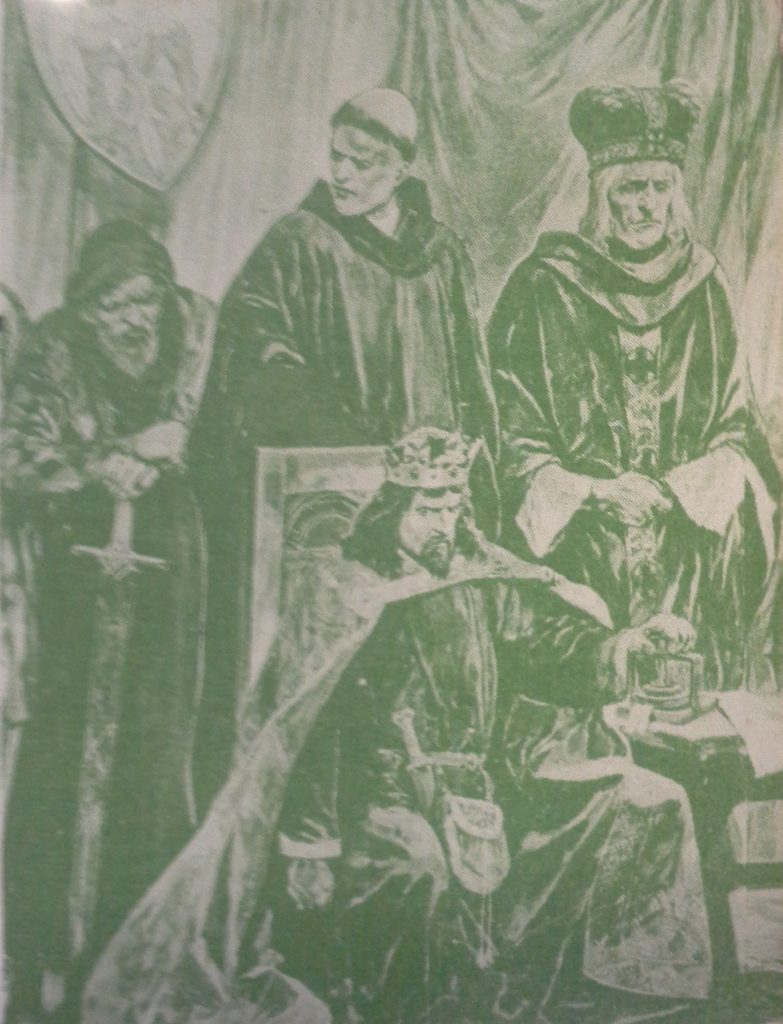
Few of the rights guaranteed in Magna Carta, in the words of an early translation of the famous document (which was written in Latin).
We [the king] have also granted to all free men of our kingdom . . . all the underwritten liberties, to be had and held by them and their heirs . . . forever. . . . No scutage or aid [unusual taxes] shall be imposed in our kingdom except by the common council of our kingdom. . . . The city of London shall have all its ancient liberties and free customs, as well by land as by water . . , all other cities, boroughs, towns and ports shall have all their liberties and free customs. . . . No free man shall be taken or imprisoned or dispossessed or banished or in any way destroyed . . . except by the lawful judgment of his peers or by the law of the land. To no one will we sell, to no one will we refuse or delay right or justice. . . .
In this way, Parliament slowly developed into a lawmaking body. During the 1300’s and 1400’s, because of several wars and in particular a long drawn out struggle with France called the Hundred Years’ War, the English king frequently had to ask for money. Parliament made use of these occasions to increase its power.
Royal power grew but was not unlimited. In the 400 years, then, between William’s victory at Hastings (1066) and the time when Henry Tudor won his crown on the battlefield of Bosworth Field (1485), England had come a long way. There had been many kings, some strong like Henry II, some weak like John. In general England had become more unified and royal power had increased. At the same time, because of Magna Carta and the growing power of Parliament, the rulers of England had been forced to recognize certain liberties of their people and to consult with Parliament in ruling the nation.
TIMETABLE SOME ENGLISH RULERS BEFORE 1603
SAXON
Alfred (“Alfred the Great”), who ruled wisely and repelled invaders, 871- 899
WILLIAM THE CONQUEROR AND HIS DESCENDANTS
William I (“William the Conqueror”) , who established Norman rule over England, 1066 – 1087
Henry II, who strengthened royal power and English law, 1154-1189
Richard I (“Richard the Lion Hearted”),
who won fame as a Crusader, 1189 – 1199
John, who granted Magna Carta (1215),
1199 – 1216
Edward I (“The English Justinian”), who conquered Wales and strengthened English law and Parliament, 1272 – 1307
TUDORS
Henry VII, who won the crown at Bosworth Field and started a new dynasty, 1485 – 1509
Henry VIII, who established the Church of England, 1509 1547
Edward VI (“The Boy King”), 1547-1553
Mary I, who tried to re-establish Catholicism in England, 1553 – 1558
Elizabeth I (“Good Queen Bess”), whose reign was one of the high points in English history, 1558 – 1603
Dates indicate length of reign.
2. How Did Royal Power Increase in Tudor England?
The Tudors strengthened royal authority in England. For over a hundred years (1485-1603) the Tudor family ruled England. First there was shrewd Henry VII, about whom you read at the beginning of this chapter. As the first in a new line of kings, Henry VII had to “watch his step.” Otherwise he might lose his crown and even the head that wore it! Henry VII crushed the feudal nobles who opposed him, but with less cruelty than was the custom of the times. Rebels often paid their penalties in heavy fines rather than with their lives. By his able and at times stingy policies, Henry built up royal wealth.
Following Henry VII there was his son, swaggering Henry VIII. Then Henry VIII’s three children — Edward, Mary and Elizabeth ruled in that order. The Tudor kings and queens ruled more firmly than earlier monarchs had. Tired of feudal warfare, the English people willingly accepted increased royal power. Moreover, the nobles, weakened by civil war, lost the power to make and unmake kings. The Tudor rulers were often cruel, but they were tactful and patriotic and were popular with their Subjects.
Two Tudor rulers after Henry VII, namely Henry VIII and Elizabeth I, deserve special comment.
Henry VIII was a headstrong king. Henry VIII was crowned King in 1509. The following description of the young monarch was written by a visitor to the English court about that time:
His majesty is about twenty-nine years of age, as handsome as nature could form him . . handsomer by far than the king of France. He is . . . fair; and as well proportioned as possible. When he heard that the king of France were a heard, he allowed his to grow also, which being somewhat red, has at present the appearance of being gold. He is an excellent musician and composer, an admirable horseman and wrestler. He pos sesses a good knowledge of the French, Laiin, and Spanish languages, and is very devout. . . A He is uncommonly fond of the chase on horseback, and never indulges in this . . . without tiring eight or ten horses. . . . He takes great delight in howling. . . . He is very desirous of preserving peace; and possesses great wealth.
In addition to these qualities, Henry VIII was hot tempered and strong willed, with a greed for power. He was married to a Spanish princess, the widow of his elder brother. Catherine was no great beauty, but she was the daughter of the king of Spain. In those days royal marriages were commonly made to gain empire or power and not much attention was paid to the personal wishes of the royal couple. Henry’s marriage to Catherine was to have far-reaching results.
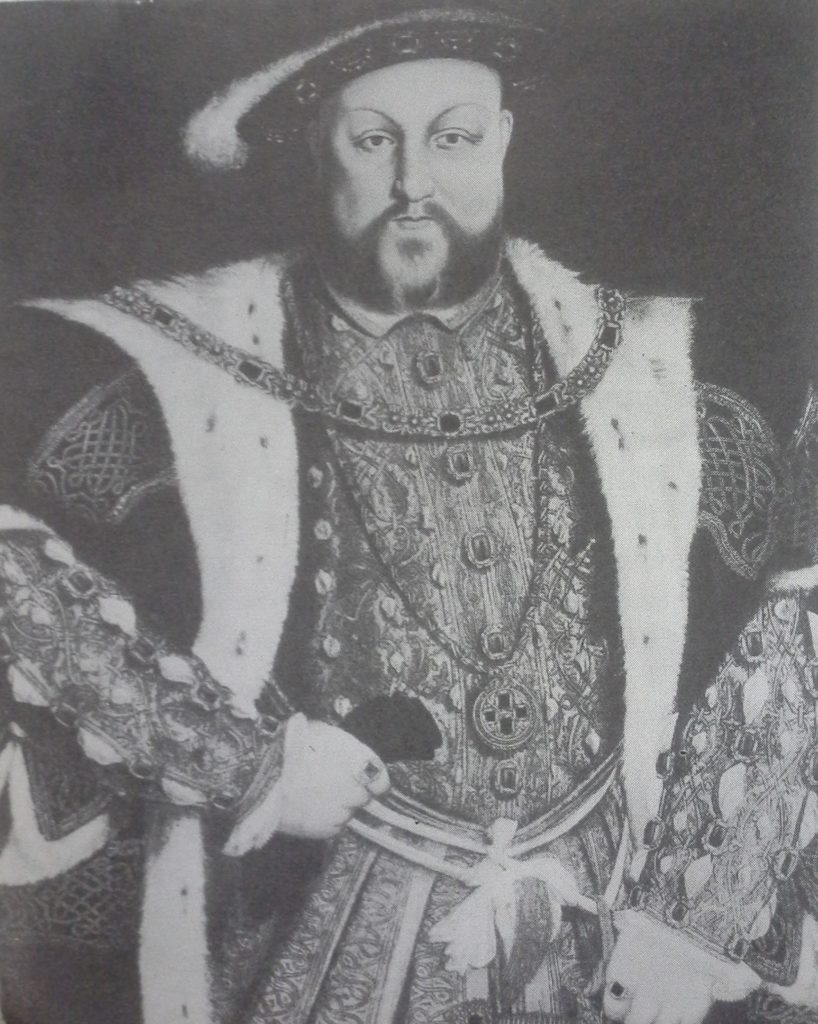
Henry VIII broke with the Catholic Church. Early in the 1500’s, in various parts of Europe, there was growing discontent with the Roman Catholic Church. Much of this dissatisfaction grew out of the influence which the Pope exerted in matters of government. Furthermore, churchmen often controlled large estates and great wealth. Some kings resented having the Pope or other churchmen limit royal power in any way.
Henry VIII was one of these kings. As a young man he wrote a book on religion which so delighted the Pope that he conferred on Henry VIII the title “Defender of the Faith.” But the Pope felt differently when King Henry insisted on turning over to his royal courts cases that had formerly been tried in Church courts. Such a move would weaken the power of the Church in England and strengthen the king’s position.
Henry VIII went still further. This strong willed monarch was determined to have his marriage to Queen Catherine set aside, because he wanted a new wife. When the Pope would not dissolve the royal marriage, Henry VIII angrily did so himself without the Pope’s consent. Then Henry married a slim, bright eyed girl, Anne Boleyn.
Meanwhile Henry VIII had inflicted heavy fines on churchmen who had received agents of the Pope without the King’s approval. Henry VIII also took upon himself the right to appoint bishops in England and he ended the payment of fees by Englishmen to the Church in Rome.
The Church of England was established. A series of laws was rushed through Parliament, which ended all ties between the Church of Rome and the Church of England. Chief among these laws was the so called Act of Supremacy (1534). Part of this law declared that “by authority of this present Parliament . . . the king our sovereign lord, his heirs and successors, kings of this realm, shall be taken, accepted, and reputed [considered] the only supreme head on earth of the Church of England. . .”
The Church of England, then, no longer recognized the authority of the Pope. Its bishops were chosen by Henry, Prominent Catholics who refused to support the Act of Supremacy were condemned to death for treason. Monasteries, with all their lands and wealth, came under the king’s power. In its beliefs and services, the Church of England at first differed very little from the Catholic Church. Later, the custom of holding church services in English instead of Latin spread. As time went on, more and more changes were introduced in the Church of England services and customs. The Episcopal Church in is descended from the Church of England.
Henry VIII left a strongly-knit kingdom. There is little need to describe further the career of Henry VIII. He married six times in all; twice he dissolved his marriage; twice he had his wives beheaded; one wife died a natural death; one out lived him. Yet this selfish English king was a skillful diplomat and a patriot. He left England a mightier nation than he found it.
Troubled years followed Henry Vlll’s reign. In 1547 after a reign of nearly 40 years, Henry VIII died. Edward VI, his sickly son, ruled only a few years. Then Mary the daughter of Henry and Catherine, became queen. She was an ardent Catholic, married to Philip II, King of Spain. Together Mary and Philip planned to restore the Roman Catholic faith in England. Hundreds were put to death as religious persecution swept over England. Mary ruled only five years. Then her half sister, Elizabeth I, daughter of Henry VIII and Anne Boleyn, became queen.
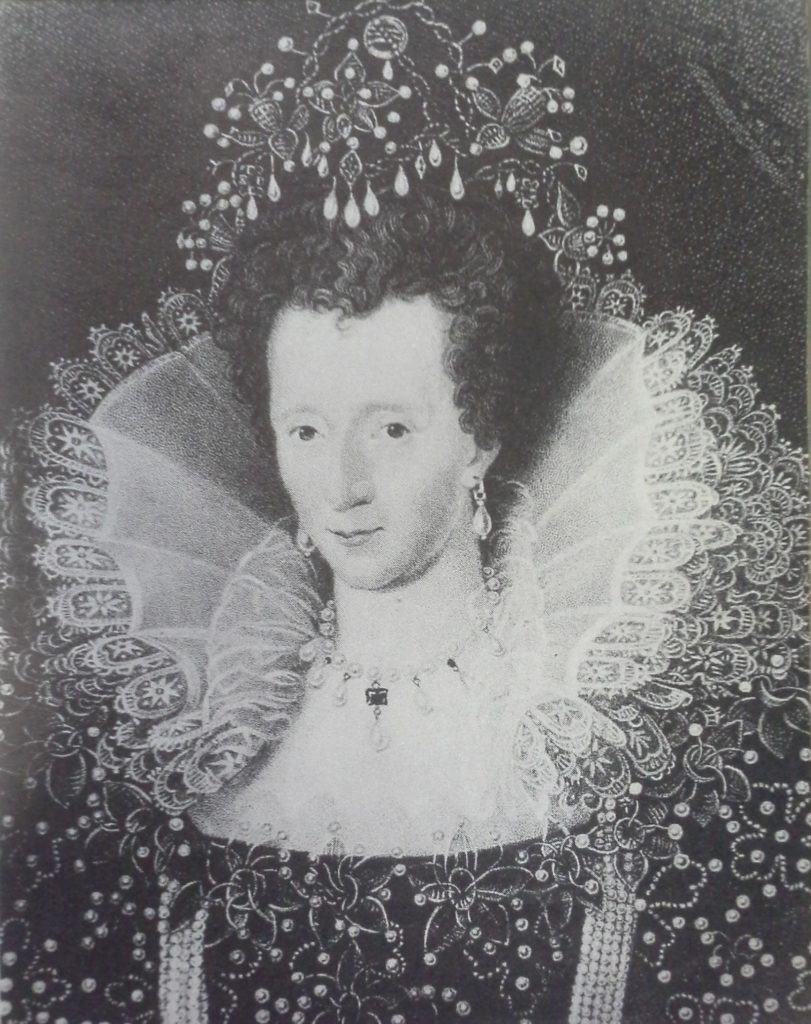
Queen Elizabeth ruled England long and well. Good Queen Bess, as Elizabeth was sometimes called, was tall and slender, with auburn hair and a high-arched nose. Although many a prince and king asked for her hand, Elizabeth never married. At times she would sulk and storm and scold, then she would be all smiles and charm. These sudden changes of mood did not mean that Elizabeth was weak or flighty. Though vain and often deceitful, she was extremely strong minded and knew exactly what she was doing. Furthermore she knew how to influence people.
Queen Elizabeth’s long reign, from 1558 to 1603, was noteworthy for several reasons:
1. Foreign policy. Elizabeth managed to keep England at peace during most of her reign. Quarrels with other nations that had been brewing at the time she became queen were patched up. Elizabeth realized (a) that wars make high taxes necessary; (b) that high taxes make people discontented; and (c) that the easiest and safest way to rule any country is to keep its people prosperous and happy.
There was one important exception to this policy of peace. Elizabeth encouraged bold English sea rovers to capture Spanish ships. As a result, Spain attacked England in 1588. Happily for England, a huge Spanish fleet was defeated and most of it destroyed. England, saved from invasion, gradually became the world’s strongest sea power.
2. Religion. The Church of England, which Elizabeth restored, grew stronger. Differences between this national church and the Roman Catholic Church grew wider after Parliament approved the “Thirty Nine Articles,” which set forth the basic beliefs and practices of the Church of England. Catholics who did not accept the Church of England were often suspected of plotting against Elizabeth and severely treated.
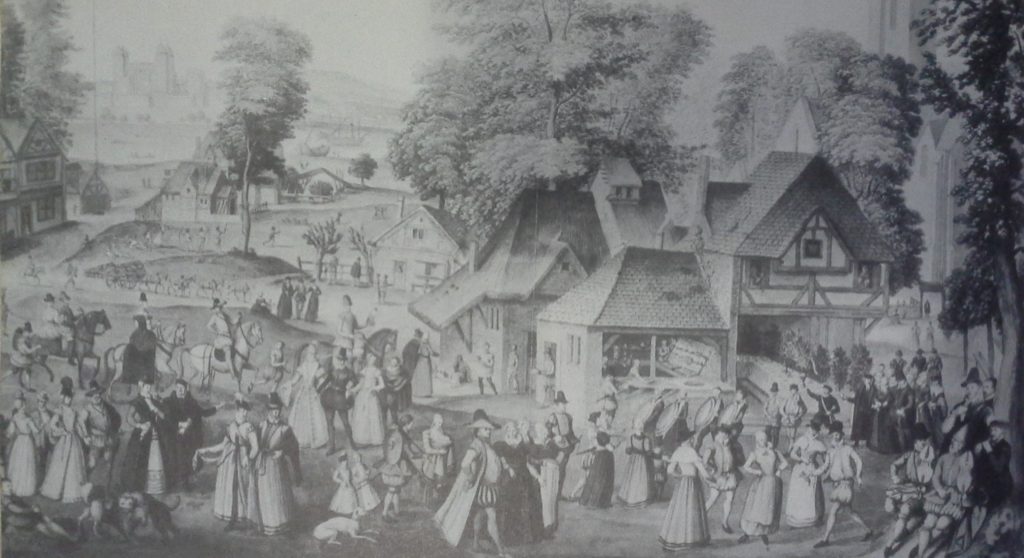
3. Industry and commerce. During Elizabeth’s reign, laws were passed to promote industry and commerce. What would you think of a law that said you had to wear a woolen cap on Sunday? In England in the 1500’s such a law was passed in order to help create a market for woolen goods. Government regulations also increased the number of years apprentiees had to spend learning their trade. The purpose of these regulations was to improve the quality of English made goods. Other laws encouraged shipbuilding and trade.
These various regulations brought increased prosperity to England under Elizabeth. Prosperity, however, was enjoyed principally by large landowners, merchants and owners of shops where goods were made. Farmers who rented land from owners of large estates lost their livelihood when these landoumers turned their farmlands into sheep pastures to gain greater profits. As one Englishman had put it even in the days of Henry VIII, “Sheep are eating men!” Many ex-farmers joined the ranks of the unemployed in English towns and cities.
Such undesirable conditions led Elizabeth and Parliament to take steps to help the poor and unemployed. Laws were passed which placed responsibility on each local community to look after its own poor and levied taxes for their support on those who were better off. Although these Elizabethan Poor Laws failed to do away with poverty and unemployment, they improved conditions greatly.
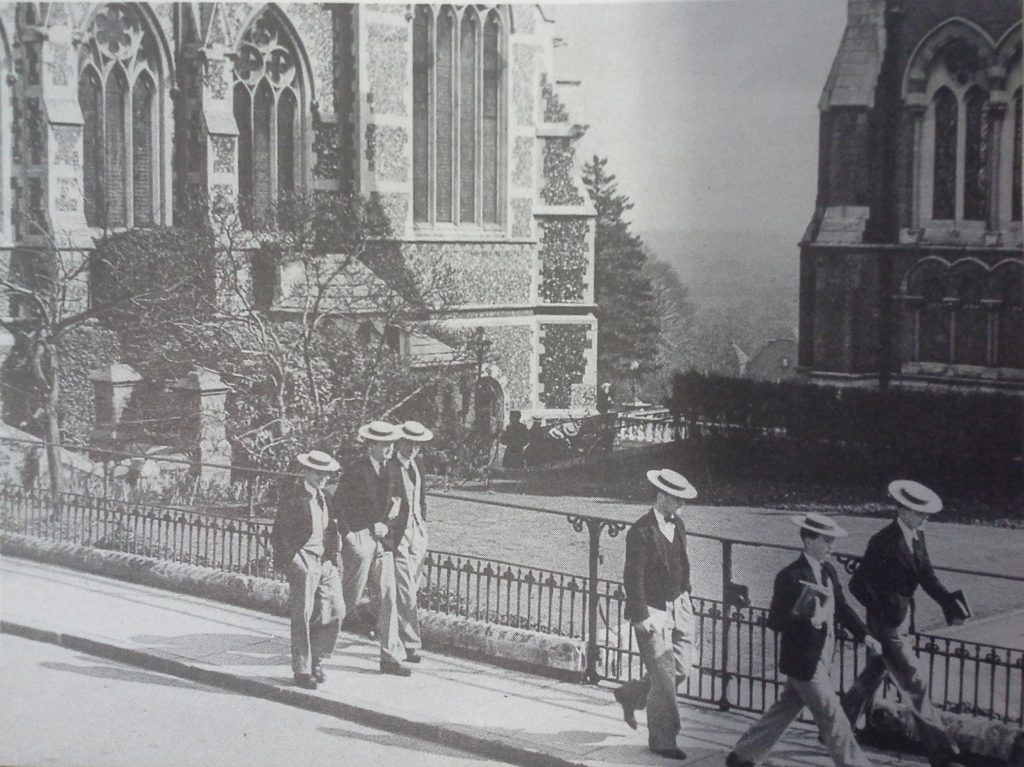
4. The Elizabethan Age in literature. Education was not far advanced in England in the late 1500’s. Those parents who could afford to, sent their children to the “petty” schools found in most of the towns and cities. Such schools, often established by wealthy people, charged fairly low fees but taught little more than the three R’s. An English farmer early in the 1600’s had this to say about what was learned in the “petty” schools:
. . . with us, this is all we go to schools for: to read common Prayers at church, and set downe common prices at markets; write a letter and make a Bond; set downe the day of our Birth, our Marriage Day, and make our wills. . . .
Only the privileged few continued their studies in grammar schools, in boarding schools like Rugby and Harrow and in the universities at Cambridge and Oxford. But these few were the ruling class of England.
Even though schooling was limited, Elizabeth’s reign was noted for a literature which stirred pride in the nation and its queen. There were the poems by Edmund Spenser which glorified England. One of these poems, “The Faerie Queenie,” describes an imaginary queen and brave knights who fought and overcame evil. Spenser, of course, had in mind Queen Elizabeth and members of her court.
For all classes, whether highly educated or not, the theatre of Elizabeth’s time supplied outstanding plays. Today, high school students usually think of Shakespeare’s plays as something to be read in English classes. Had you lived in the fast growing city of London in Elizabeth’s day, however, you would have found people flocking to the Globe Theatre to see the much talked of plays of William Shakespeare being acted, with Shakespeare himself sometimes playing roles. Englishmen of all classes liked Shakespeare’s plays, not only because the characters were shrewdly portrayed but because some of his historical plays stirred English pride by recalling half forgotten events in their history. Another famous playwright of those times was Ben Jonson, who wrote comedies which pictured English life as it was about 1600.
During the Elizabethan Age, then, England was a strong, unified, prosperous kingdom. Though Englishmen were the subjects of a powerful and sometimes willful queen, they enjoyed certain well established rights and had some voice in their government. They took pride in the history and progress of their country. Shakespeare spoke for them when he referred to England and the English people as
This happy breed of men, this little world, This precious stone set in the silver sea. . . This blessed plot, this earth, this realm, this England. . . .
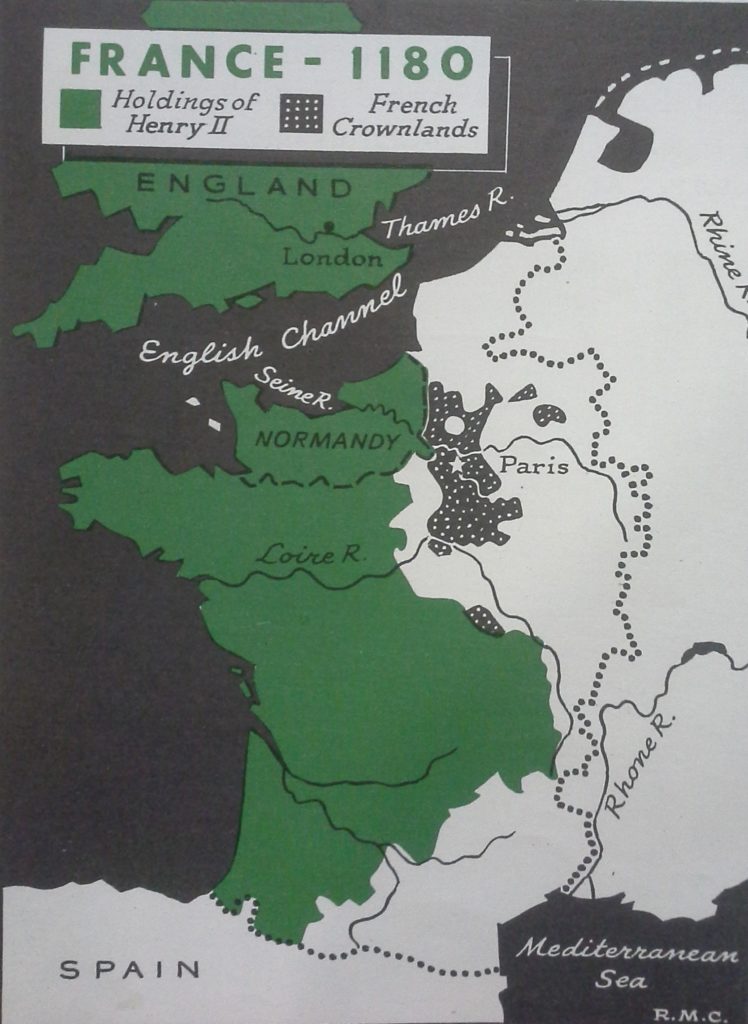
3. In What Other Parts of Europe Did Strong Monarchies Develop?
The feudal system lasted longer in France than in England. Kings had more trouble building up royal authority in France than in England. After Charlemagne’s death there was great disorder in France. Local lords ruled about as they pleased; invading Norsemen raided the country; and the grand sons of Charlemagne added to the confusion by quarreling among themselves. In 987 a group of the greater and more powerful lords chose one of their number as king. This man was Hugh Capet, Count of Paris. As king, however, Hugh Capet actually ruled only his own section of the country. Most of France was still controlled by great nobles, some of whom had as much power as the king himself. Nowhere in Europe was the feudal system of fiefs and vassals more completely in operation than in France.
Philip Augustus strengthened royal power. A step toward stronger central government took place after 1180 when Philip Augustus became king. Among the great vassals of the not so great French rulers were England’s kings who held more than half of France. Philip seized every opportunity to weaken their hold over French lands. He had little success against Henry II, but soundly defeated King John. Though English kings still held portions of France, Philip won control of Normandy and several other sections. Philip now controlled enough of France so that he had more soldiers and power than any of the great French lords.
St. Louis established king’s courts and judges. Few kings have been called saints, but Louis IX, who died in 1270, was one of the few who deserved the name. He put down the lawless violence of the French feudal lords. He replaced trial by ordeal and by combat with a system of royal courts and trained judges. Knowing, however, that the best of court systems could not always give complete justice, he held open court himself from time to time. On these occasions St. Louis sat under an oak tree and listened to anyone, noble or serf, who wanted to appeal to the king for justice.
Philip the Fair increased kingly power. Philip the Fair, who reigned from 1285 to 1314, was a very different kind of man from his grandfather, Louis IX, but he too helped to strengthen royal power in France. Many of this king’s gains were at the expense of the Church. When a dispute arose over the right of the king to tax clergyman, Philip forbade Frenchmen to send gold or silver out of the country. Such a command was a serious blow to the Pope because it reduced the income of the Church. A bitter dispute between Philip the Fair and the Pope developed over this and other incidents. For nearly 70 years the Popes were obliged to live in France, where they came under the influence of French kings. Later there were even two Popes at the same time, one at Avignon, France and the other in Rome.
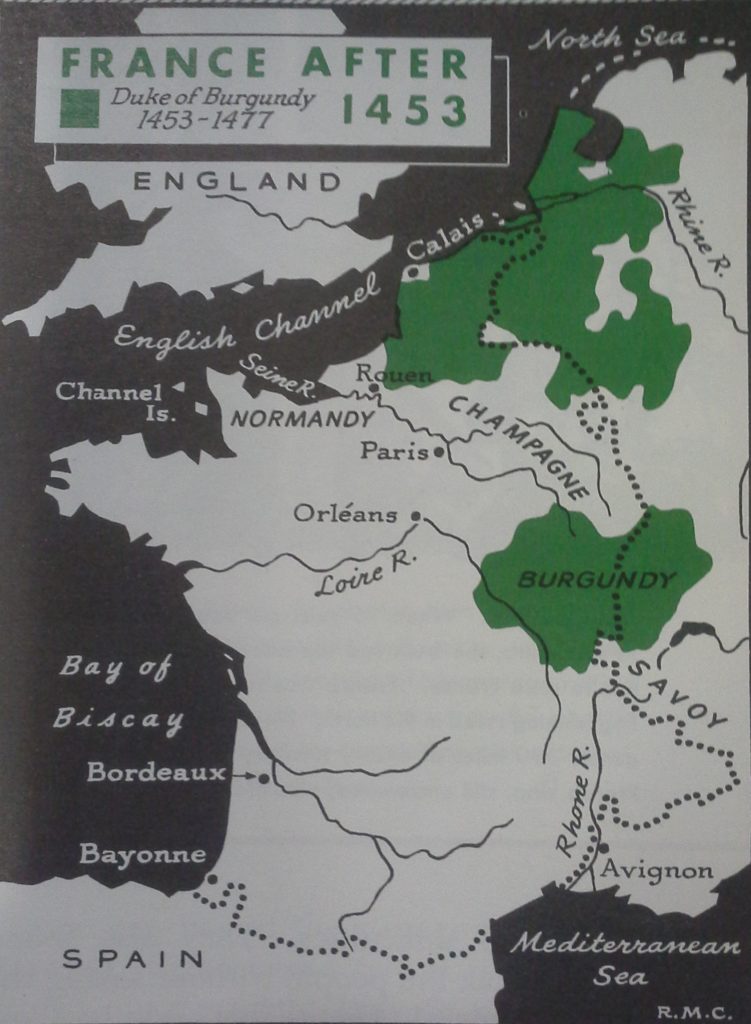
Philip the Fair also came into conflict with the Church when he seized the property of the Knights Templar in France. This wealthy order owned lands and other property that Philip wanted. So, even before Henry VIII of England seized monastery lands in England after breaking with the Pope, Philip the Fair had seized Church property in France.
A great council was formed in France. In order to gain greater support in his dispute with the Pope, Philip the Fair in 1302 called together representatives of all estates, or classes of people, in France. One estate was the clergy, another the nobility and the third included the common people. This council of the three estates, called the States General, resembled the English Parliament in many ways. The States General never gained as much power. The French kings called this body together only when they were in special difficulties. They also found ways to tax the people without asking the States General. Hence this body had few chances to learn how to bargain with the king and how to control his decisions.
The Hundred Years’ War temporarily weakened French rulers. Claims made by English kings to lands in France and to the French throne brought about a long struggle known as the Hundred Years’ War. Although the fighting was not continuous, the wars which began in 1337 did not end until 1453.
During the Hundred Years’ War, French kings lost much of the power they had previously gained. In this bitter struggle France was the battleground. French fields and not English were left unplowed, French towns, not English were destroyed. The damage caused by English soldiers did less lasting harm than the disorders that followed the weakening of the French central government. Bands of professional soldiers who fought for the side which paid the highest wages became little more than bandits during the intervals of peace in the Hundred Years’ War. These undisciplined soldiers robbed and plundered Frenchmen. In addition, famine stricken peasants rose in revolt against their feudal lords, destroyed castles and caused great loss of life. To add to this suffering, there came a frightful sickness, the bubonic plague, called the Black Death. Sweeping across Europe in the mid-1300’s, the Black Death killed millions of people.
Joan of Arc rallied France. The inspired leadership of a peasant girl finally united France. Joan of Arc declared that the saints she had heard and seen in dreams and visions had directed her to free France from the English. Joan the Maid, as she was often called, brought new courage to the French soldiers. She led an army which drove the English from the city of Orleans and she had Charles VII crowned King of France. After other victories, Joan of Arc advanced on Paris. She was finally captured and turned over to the English, who arranged to have her tried as a witch before a church court. Joan was condemned and burned at the stake in Rouen, France in 1431. In spite of her terrible fate, Joan of Arc had created something new in France — patriotism or national spirit. The French people united and swept the English from their country. Nearly 500 years later, Joan was declared a Saint by the Roman Catholic Church.
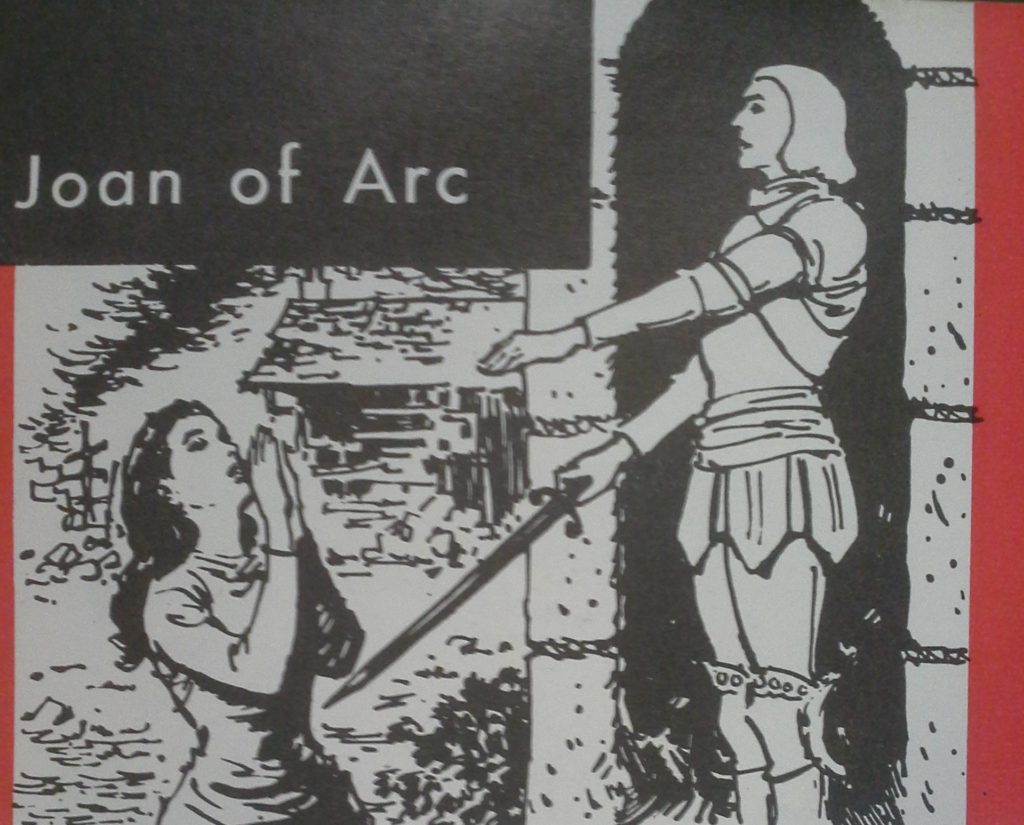
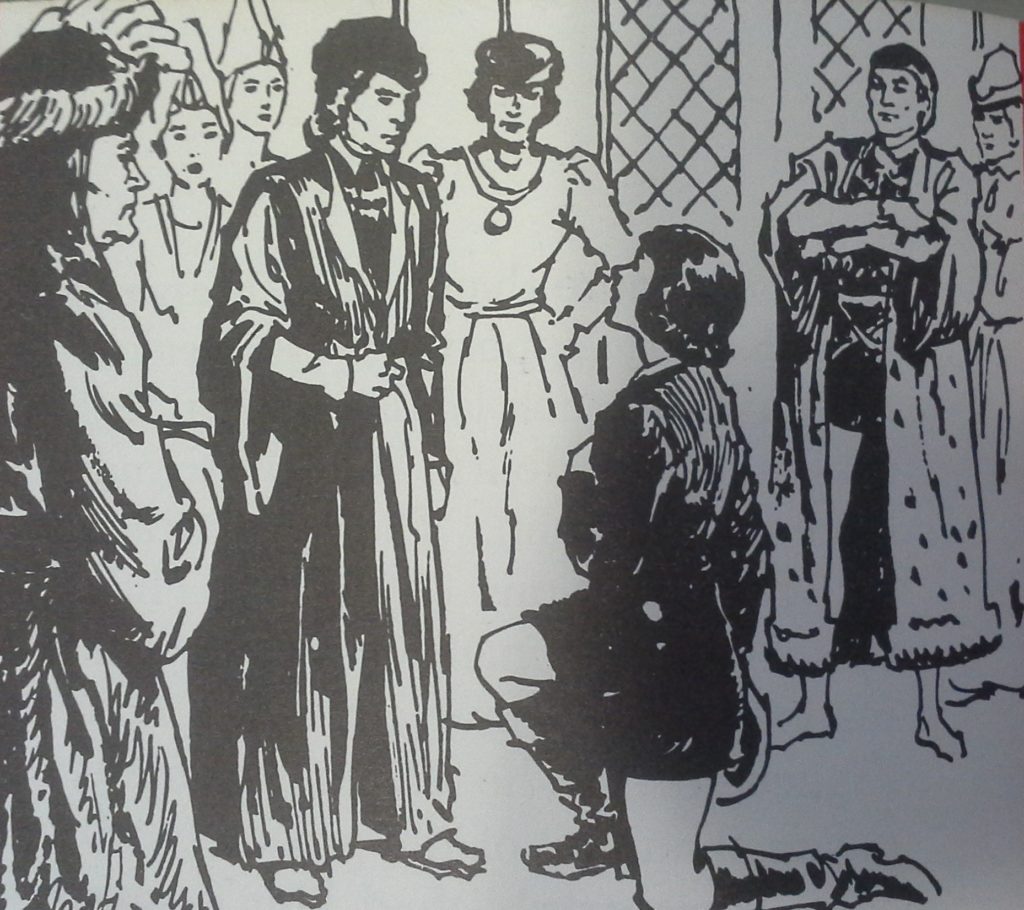
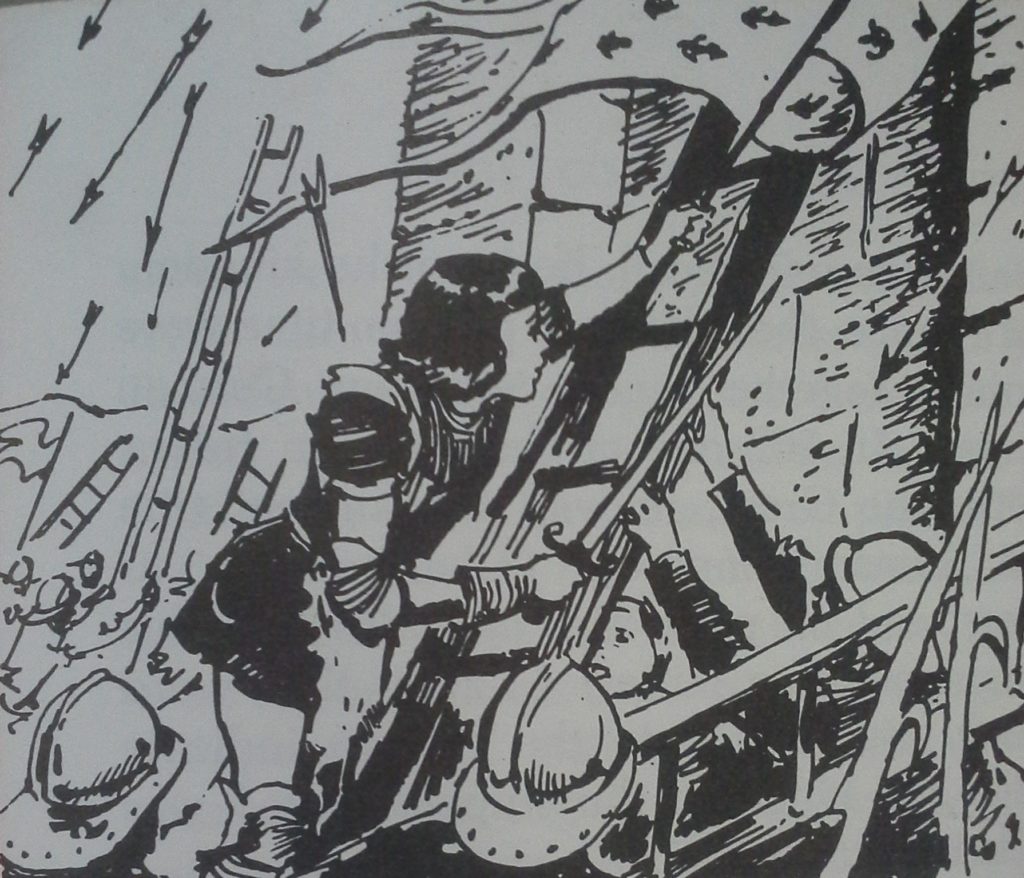
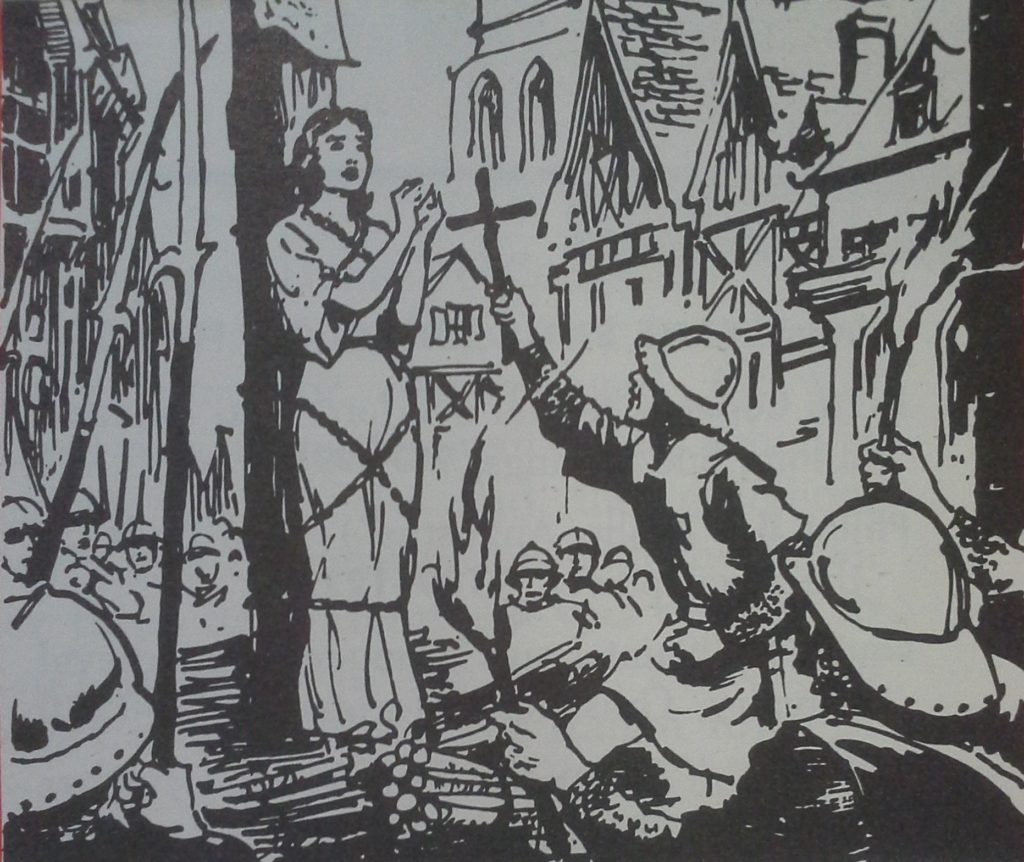
French kings overcame powerful nobles. Driving out the English was, however, only the first step in undoing the mischief of the Hundred Years’ War. The next step was to crush the proud nobles who had taken advantage of the disturbed times to make themselves almost independent of the king. Most troublesome of these powerful lords was the Duke of Burgundy, who ruled over a country inhabited by Frenchmen, Germans, Belgians and Dutch people along the eastern borders of France. Charles the Bold, as the Duke of Burgundy was called, was hot tempered and headstrong. His ambition to set up an independent kingdom brought him into conflict with Louis XI, a timid yet shrewd monarch. In the end the Duke of Burgundy’s rashness was his downfall. He made the mistake of going to war against the sturdy Swiss, who smashed his finest troops in the mountain passes of the Alps. After the death of Charles the Bold, part of Burgundy was annexed by France.
Later kings of France exercised great power. When Louis XI died in 1483, France was one of the strongest states in Europe. His successor felt so secure that he led an army into Italy to make new conquests. This started a tradition of fighting for parts of Italy that kept getting France into war for a good many years. One effect of these wars was to help spread Renaissance art and literature throughout France. The grim old castles of France gave way to graceful Chateaux — the country homes French nobles built. The French court became the gayest and most elegant in all Europe. There the great lords of France gathered, seeking ways to win their king’s favour. Step by step the French kings were drawing political power into their own hands. One man rule grew more slowly in France than in England, but it was to become more complete.
Strong monarchies developed in other parts of western Europe. The growth of strong national states under powerful rulers was not limited to France and England. For centuries Spain had been under Moslem control. Although the Christians gradually pushed the Moors (as Moslems in Spain were called) south ward, Christian Spain was still split up into small kingdoms. Then, in the mid 1400’s, Ferdinand and Isabella, the rulers of the kingdoms of Aragon and Castile, were married. The marriage of these two monarchs laid the foundation for Spanish unity. Ferdinand and Isabella stripped the feudal lords of power and strengthened royal control. In 1492, the very year when Columbus discovered America, the armies of Ferdinand and Isabella captured Granada, which was the last Moorish stronghold in Spain.
About the same time Portugal became a strong national state. Then, a little later, the Scandinavian countries to the north, which had been united under one king, broke up into the separate kingdoms of Sweden and Denmark. Norway remained under the rule of the Danes.
There was no strong authority in central Europe. The movement toward unified states under powerful rulers was not equally advanced in all parts of Europe. To understand why, you will need to think back to the three way split of Charlemagne’s empire. One part, you will recall, became the kingdom of France; the other two parts in time were joined together under vigorous German kings. In 962 one of the German rulers, Otto the Great, revived the ancient title of Roman Emperor. (Charlemagne, had also had this high-sounding title.) Later the word Holy was added to the title to indicate that the kingdom the emperor ruled was Christian.
Perhaps there is confusion at the way the word Roman keeps bobbing up in European history. (1) We know about the great Roman Empire of early times, which came to an end in western Europe in 476 A.D. (2) We also learned about the Eastern Roman (or Byzantine) Empire, which lasted until 1453. (3) The Pope called Charlemagne’s Frankish empire a Roman Empire in the year 800. (4) We find that the Holy Roman Empire appeared in the central and eastern part (including northern Italy) of what had been Charlemagne’s empire. It lasted over eight hundred years, from the crowning of Otto the Great until 1806 when Napoleon put an end to it.
Actually, the Holy Roman Empire revived by Otto was “neither holy, nor Roman, nor an empire.” It lacked the unity that its name implied. Instead it was a league of rulers in central Europe, mostly of the German speaking countries though some others were also included. Although the rulers of these states were in theory subject to the emperor they selected, they quarreled continually with him and with one another over religious and political affairs.
Holy Roman emperors were elected by nobles and churchmen. At first it was uncertain just how the emperor of this loosely organized league should be chosen. In time the selection was made by seven electors, as they were called. Of the seven, three were archbishops. The other four were the rulers of Bohemia, Saxony, Brandenburg and a region along the Rhine called the — Palatinate. Once selected, the Holy Roman emperors held office for life, because they were the only rulers in central and western Europe to hold such a high title, they possessed great dignity. They however, lacked real power to impose their will over the numerous German and Italian states.
Emperors and Popes struggled for power. On several occasions Holy Roman emperors engaged in quarrels with the Popes at Rome. Sometimes trouble arose over lands in Italy. For more than 1100 years beginning in the mid-700’s, the Popes not only had religious authority but actually governed lands in central Italy known as the Papal States. Attempts of Holy Roman emperors to increase their control over Italy led to disputes with Popes. In addition, Popes and emperors disagreed over the appointment of powerful churchmen in Germany. The emperors felt that they should appoint these churchmen and receive income from Church lands, but the Popes objected.
The most famous quarrel between a Holy Roman emperor and the Pope began in 1075. Emperor Henry IV insisted that he had the right to appoint bishops and abbots in the Holy Roman Empire. The Pope rejected Henry’s claims, excommunicated him and declared that he was no longer Emperor. Encouraged by the Pope’s acts, many German nobles rebelled against Henry. To end the rebellion, Henry had to make peace with the Pope. For three days Henry IV was obliged to stand barefoot in the snow before the Pope’s door in the small Italian town of Canossa before the Pope would talk with him. Years later, the question which had led to this bitter quarrel ended in a compromise. Bishops and abbots were to be chosen by the Church, but were to receive from the emperor the lands which they were to control.
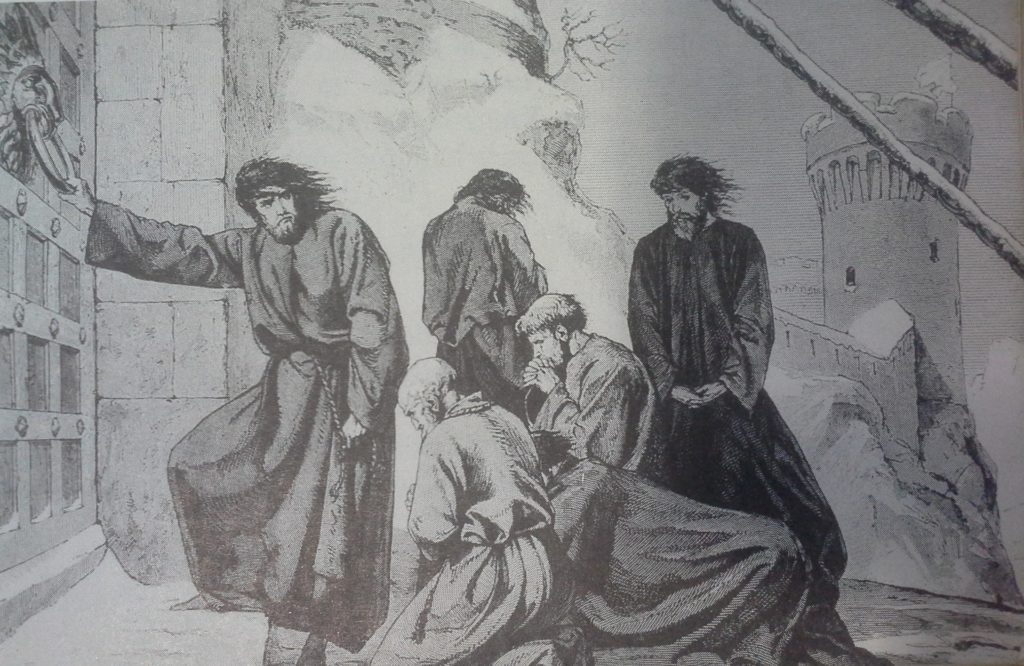
Two later emperors also had serious trouble with the Church. These were Frederick Barbarossa, meaning “Red Beard,” and Frederick II. Against both emperors the Pope stirred up revolts in the Italian cities and among the rulers of German states in the Holy Roman Empire. As a result there were periods of confusion and disorder in the loosely-knit Empire.
The Holy Roman Empire never became unified. Order was restored within the Holy Roman Empire when Rudolph of Hapsburg, an Austrian count was elected Emperor in 1273. The emperors never regained effective control over the parts of Italy they had formerly ruled. Furthermore, quarrels with the Popes and repeated wars to regain control of Italy prevented the Holy Roman emperors from cutting down the power of the great German nobles. Unlike England and France, therefore, the Holy Roman Empire failed to develop into a unified state under a truly powerful monarch. In fact, until late in the 1800’s both Germany and Italy remained divided into many small states.
IMPORTANT EARLY KINGS OF FRANCE
Hugh Capet, a feudal overlord who founded a long line of kings, 987- 996
Philip II (“Philip Augustus”), who built up the royal power, 1180 – 1223
Louis IX (“Saint Louis”), model of medieval chivalry, Crusader, reformer, 1226 – 1270
Philip IV (“Philip the Fair”), who further extended the power of the king at the expense of the Church, 1285 – 1314
Charles VII, who was kept in power by Joan of Arc but who made no effort to save her from the stake, I422 – 1461
Louis XI (“Louis the Spider”), who made the monarchy absolute by fighting and plotting, 1461 – 1483
Dates indicate length of reign.
4. What Forces Destroyed the Religious Unity in Western Europe?
Problems plagued the Catholic Church in the later Middle Ages. We have already learned in how certain English and French monarchs and Holy Roman emperors defied the Pope and the Catholic Church in their efforts to increase royal power. Kings and emperors felt (1) that the Church had too much political power and land; (2) that it caused too much wealth to flow from the homeland to Rome; and (3) that it weakened their authority.
Quarrels with rulers of national states were not the only problems of the Catholic Church between 1300 and 1600. As kings asserted their authority and as loyalty to royal governments increased, many people were less willing to accept control from outside their own country. As trade and commerce spread, businessmen resented the fact that the Church frowned on interest and profits. As study of Greek and Roman ideas revived during the Renaissance, some men began to question the doctrines of the Catholic Church. There were outbreaks of heresy, that is, the teaching and practice of religious ideas contrary to those approved by the Church.
Finally, there was discontent over the worldliness of some churchmen in high positions. Such worldly churchmen, usually nobles, considered themselves a privileged class. They performed certain routine duties for the Church but did not dedicate their lives to helping and serving other people. Many loyal, faithful churchmen recognized the danger to the Church of certain practices that had arisen. For example, they objected both to the sale of Church offices for money and to giving them to relatives as a favour.
All these conditions provided materials for an explosion. Martin Luther, a German monk and college professor, supplied the spark which set off the explosion in 1517.
Martin luther searched for salvation. Luther’s father, a well to do German farmer, gave his son a good education. When Martin decided to go into a monastery, his father was disappointed, for he had hoped that his son would make a name for himself. To Martin Luther the only thing worth while was to save one’s soul. The young monk prayed night after night, he half starved himself with religious fasts, he went on pilgrimages to holy places. Finally he came to the conclusion that God was not satisfied by an outward show of penitence, or sorrow for one’s sins. Instead, Luther thought, it was necessary to throw oneself wholly on God’s mercy.
Luther attacked the sale of indulgences. Luther was aroused when a Dominican friar named Tetzel came to Germany.
The Renaissance World
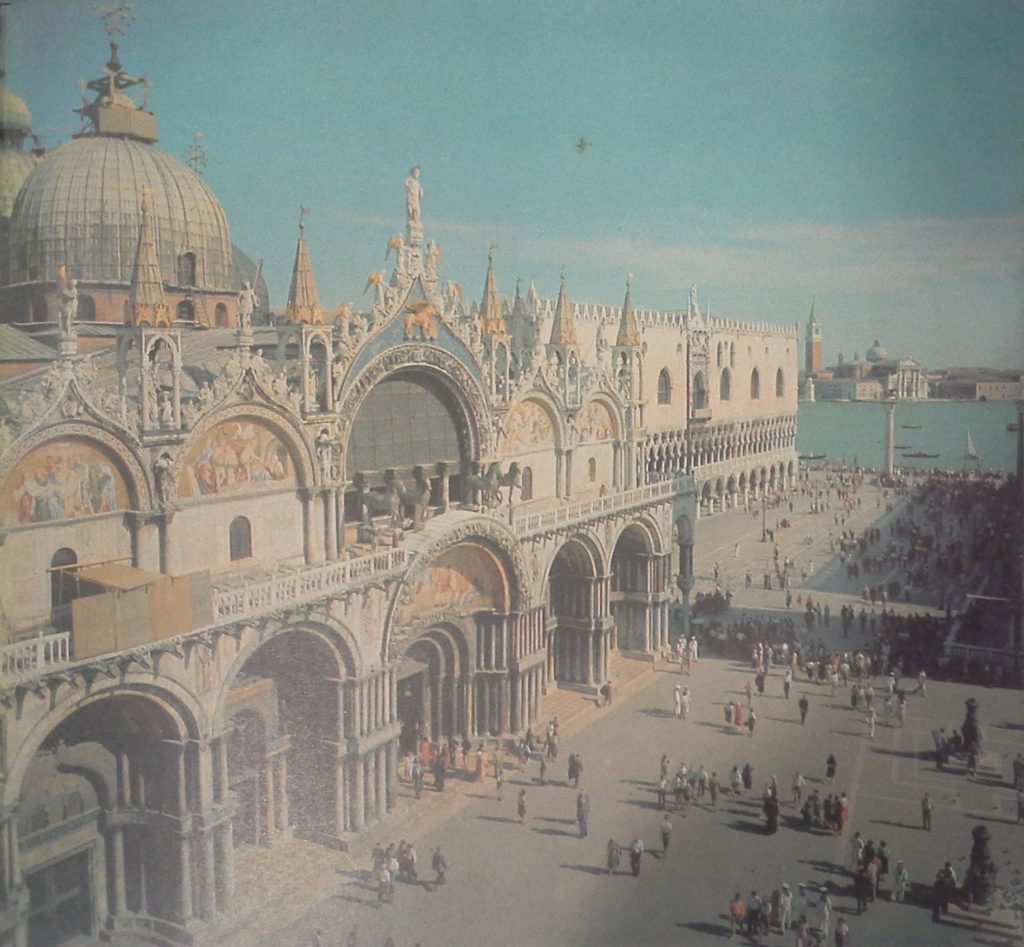
For centuries the wide public square (above) of the Italian port of Venice was Europe’s chief “gateway to the East.” Here, where they could keep an eye on the harbour, strolled the Venetian merchants and ship owners who controlled the trade routes to Constantinople and the Moslem ports. Like other European cities, Venice had a great cathedral (left), dedicated to St. Mark. But unlike other European cathedrals St. Mark’s was built in a style imported from Constantinople. Within its round arches were murals made of mosaic in the Byzantine manner. Above the centre doorway you can see four bronze horses which were brought back from the Hippodrome stadium in Constantinople by a Venetian crusading expedition.
The flow of new styles and ideas from the East set off a Renaissance or revival of learning in the cities of Italy. Italians eagerly read the Iong-forgotten books of the Greeks and Romans which had been preserved at Constantinople. They also studied the more recent writings of the Arabs. These different viewpoints inspired Italians to produce new ideas of their own.
From Italy the Renaissance spread gradually to France and the Low Countries. Everywhere in Europe the pace of life quickened. Europeans felt freer than they had in the early Middle Ages. They became aware of new and exciting opportunities — better ways to make a living, new subiects worth studying, strange lands to explore. With their minds full of new ideas, it is no wonder that people were bursting to express themselves. From the beautiful buildings, paintings and statues which they created, we can see how the changing world of the Renaissance looked to them.
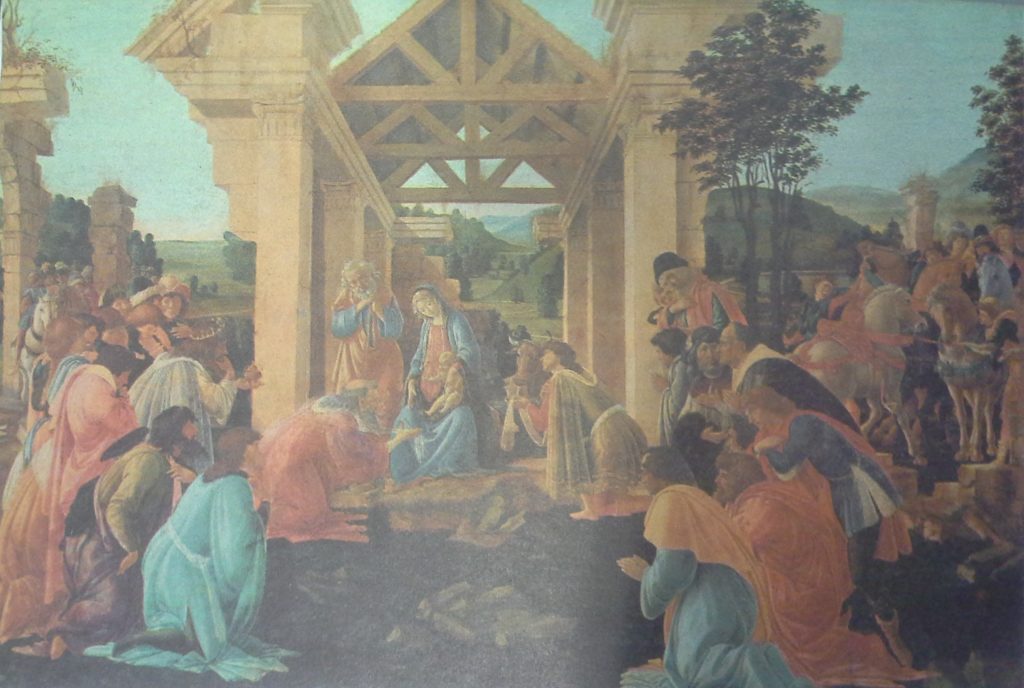
In the 1400’s, questions of religion were very much in the minds of Europeans. Italian painters turned out thousands of pictures of the Madonna and the saints. They painted these religious subiects differently than had medieval artists. Look at the picture above of the visit of the three kings to the infant Jesus. Unlike medieval paintings (pages 235, 236), it has a natural-looking background. The green, rolling hills and the soft light of the sky show that the artist had a keen eye for the natural world around him. Together with the building, the landscape also shows the artist’s ability to paint things in perspective — that is, to paint them as they look at a distance or from different angles.
The people of the Renaissance liked both individuals, and they beautitied their public squares with statues of heroes like that of a famous general, Colleoni, on his horse (right). In the Middle Ages, anyone thought worthy of a big statue was likely to be a saint, a king, or a great noble. Colleoni was none of these. He was a profes sional soldier, hired by the merchants who governed the cfty-state of Venice.
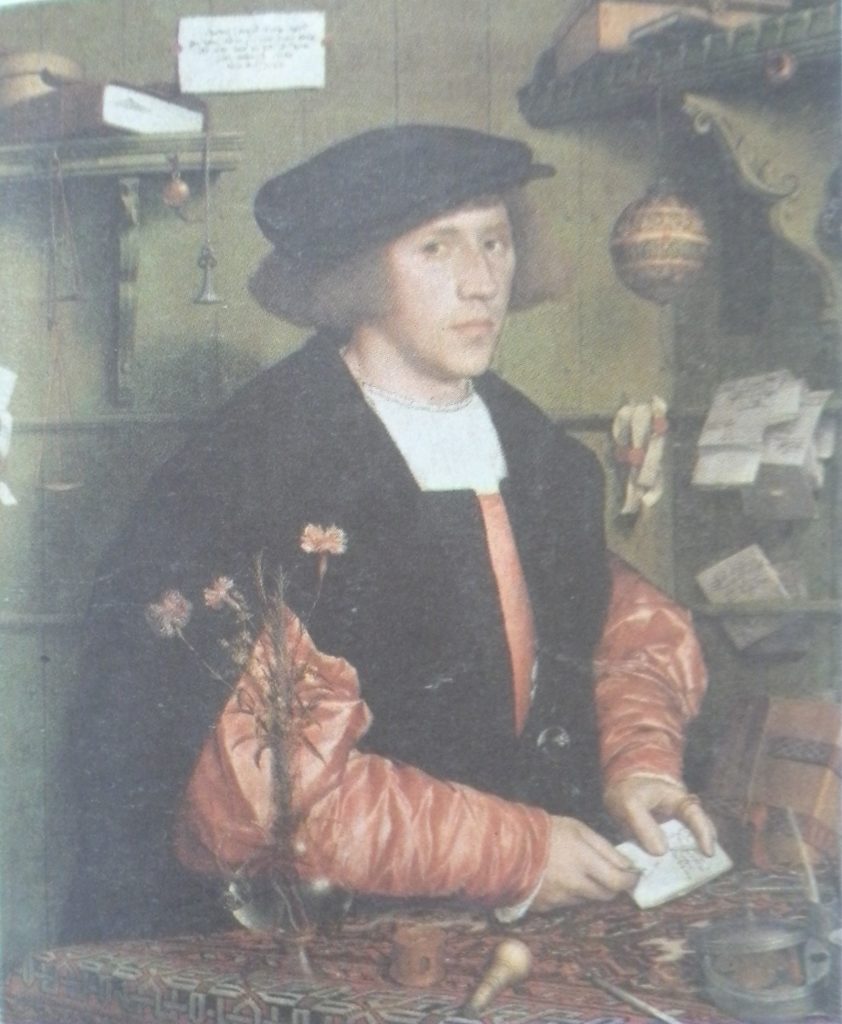
The Renaissance brought more influence to new classes of people, especially in the towns. The continued increase in buying and selling made the middle-class merchants wealthy and powerful, not only in Italy but in northern countries. A famous artist like Hans Holbein, who pointed portraits of King Henry VIII, was happy to do the same for a merchant.
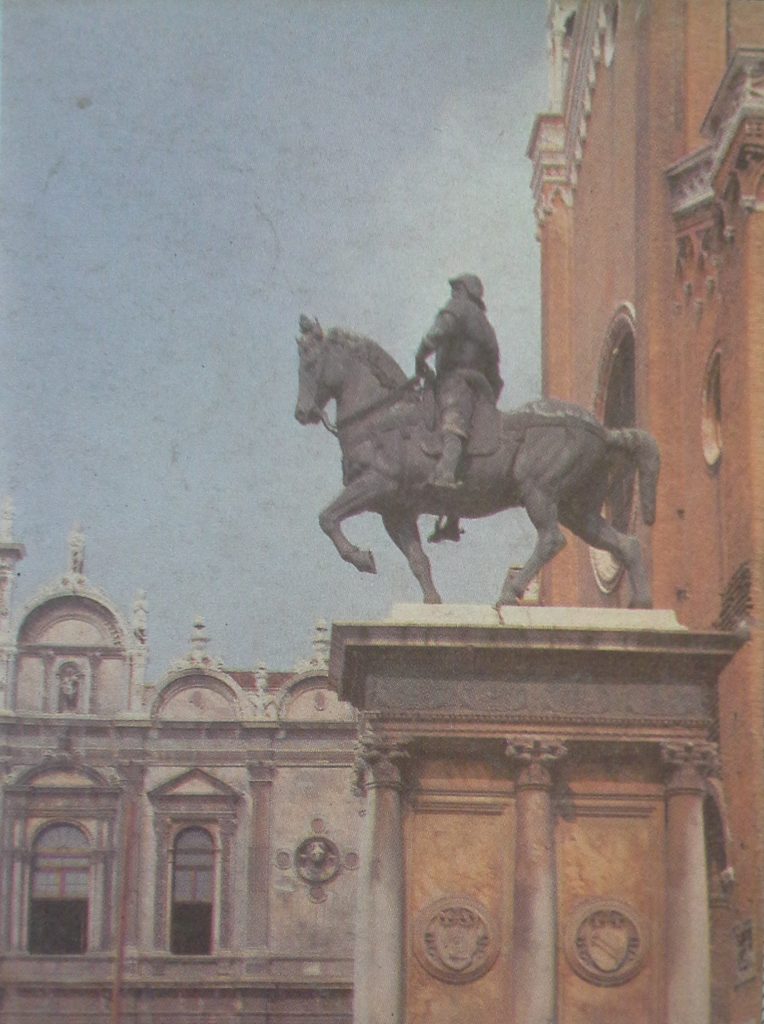
As you can see, Holbein was not content to paint things just so they could be recognized. He shared the new scientific curiosity about the real world. Holbein was interested in showing exactly how different materials — the red satin of a merchant’s sleeves, or a crystal vase of flowers looked in different lights. Holbein and his fellow painters in Italy and the Netherlands found plenty of rich materials to paint. Their customers liked to surround themselves with luxuries, like the elaborate gold dish.
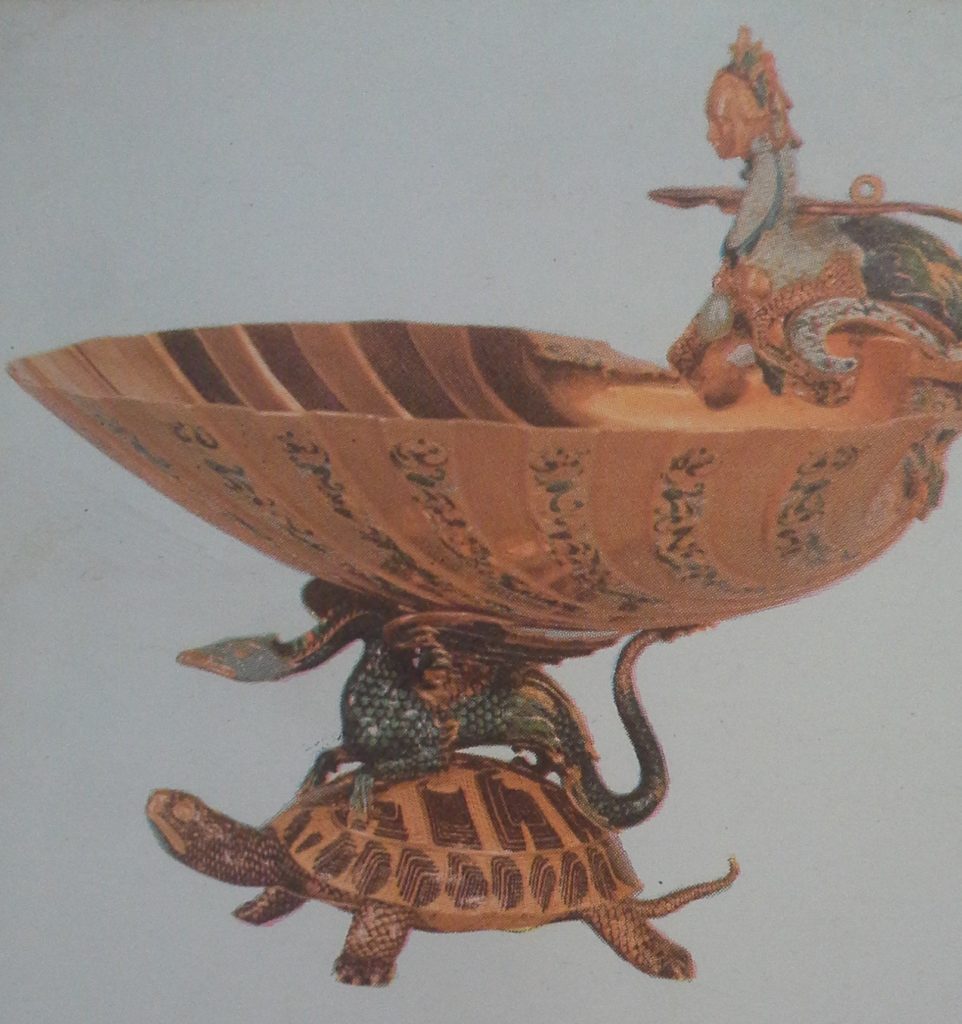
The widening outlook of Renaissance people made them interested not only in new ideas but in history and the strange beliefs of people in the past. As a result, they liked paintings which showed the heroes and gods of the ancient Greek and Roman myths. For example, in the 1600’s the Flemish artist Rubens painted the picture below of Neptune, Roman god of the sea, calming a storm. Notice how the rippIing muscles stand out on Neptune and his sea horses. Rubens knew how to paint both men and animals in motion. He knew why the muscles moved in various ways because Renaissance artists studied anatomy scientifically. Renaissance artists liked to ”catch” gods or people in action in their paintings. This was because they believed that man was ”going somewhere” — in other words, that life had many possibilities and that man could do almost anything if he would make the effort.
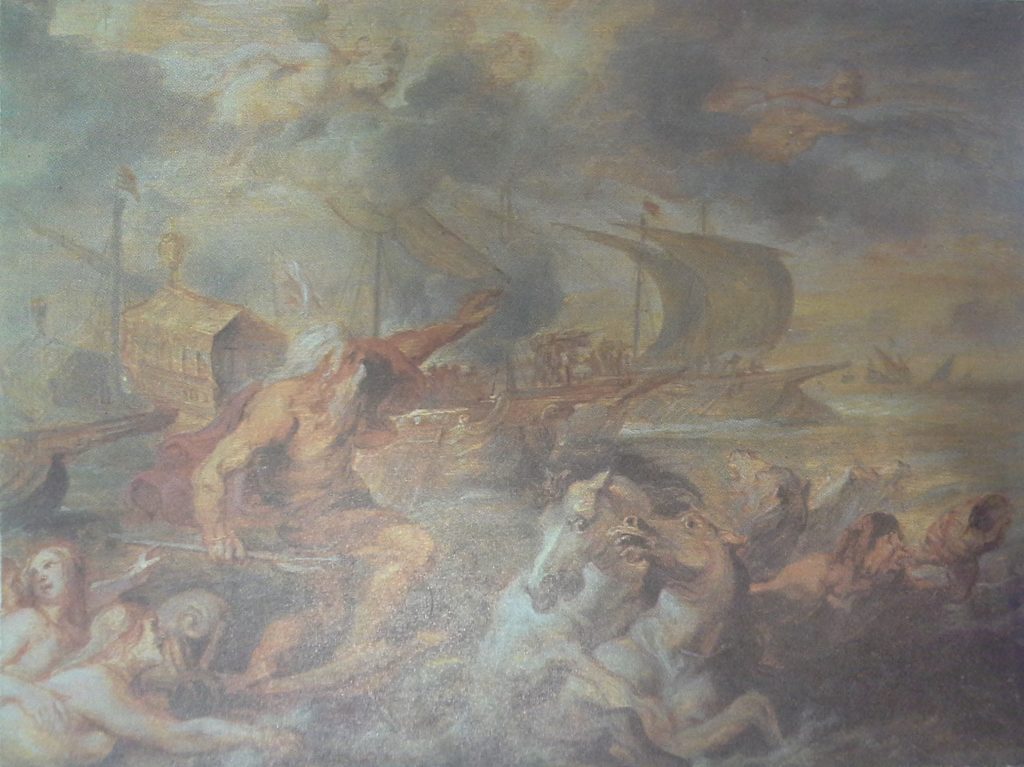
Tetzel was a seller of indulgences, a practice which needs explanation. Catholics believe that the soul must be cleansed of sin by the sacrament of penance. This sacrament has several parts: (1) feeling heartily sorry for one’s faults; (2) confessing them to a priest; (3) performing or promising to perform some act of penitence as an outward sign that one has repented; (4) receiving absolution, or pardon, from the priest. In those days the act of penance might be a fast, a pilgrimage, the saying of certain prayers, or a payment of money to charity or to the Church.
Tetzel wanted to raise money to build St. Peter’s Cathedral in Rome. He taught that giving money to the Church was sufficient proof of penitence and that pardon for one’s faults would follow. Tetzel’s too simple statement of Church doctrine disturbed many Catholics. Among them was Martin Luther, who was now a professor in the University of Wittenberg. He listed 95 points about penance and the sale of indulgenoes which he wanted to debate with Tetzel. In 1517 Luther tacked his list onto the church door at Wittenberg, since church doors in those days served as town bulletin boards. The Pope and Catholic priests could grant an indulgence from the penalty for sin, argued Luther, but pardon for the sin itself must come from God. The Church should do what it could for the sinner, he went on, not from love of money but from charity. The indulgence might take the place of the punishment for sin set by the Church in this world, Luther felt, but the Church could not limit either God’s mercy or God’s justice in the world to come.
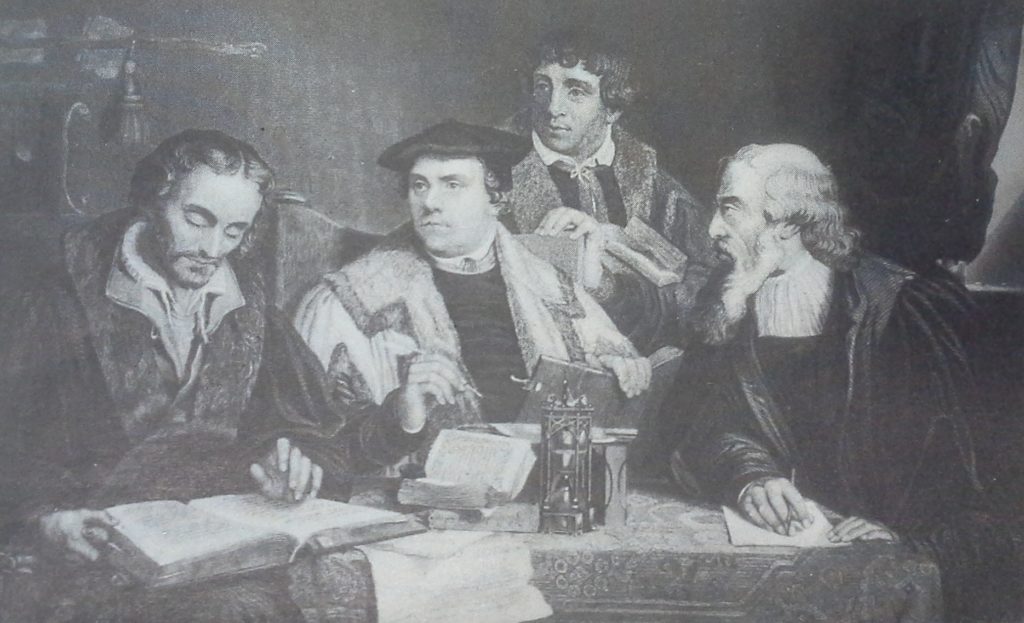
Martin Luther, leader of the Protestant Reformation, is the second figure from the left in this pointing. Luther and other scholars are preparing a German translation of the Bible.
Luther begun a Protestant revolt. Bitter arguments followed. Some people agreed with Luther, some did not. Finally, Church officials declared that some, though not all, of Luther’s views conflicted with official views of the Church. In 1520 the young monk replied by publicly burning the copy of the Pope’s decree against him. A number of German nobles backed Luther; but the Holy Roman Emperor, Charles V, supported the Pope in condemning him. When Luther refused to change his views, he was declared an outlaw. In the city of Worms, Germany, where he was brought to trial the following year, Luther declared, “Unless I am convicted of error by the testimony of Scripture . . . I cannot and will not take back anything, for to act against our conscience is neither safe for us, nor open to us. On this I take my stand. I can do no other. God help me, Amen.”
Luther had to go into hiding for a while, but a powerful German ruler, the Elector of Saxony, protected him. Many rulers and nobles felt that the Catholic Church limited their own authority and were willing to support opposition to it. Soon half of Germany rallied around the bold young reformers. The newly invented printing press spread his pamphlets and his German translation of the Latin Bible. It soon became evident that Luther must keep his followers from going to extremes. When the peasants rose in revolt against the nobles, Luther told them that all he aimed for was freedom of the soul and that how people were governed or earned their living was no concern of his.
The movement which Luther started is sometimes called the Protestant Reformation, or, more briefly, the Reformation. When the Holy Roman emperor tried to crush it, there was widespread protests. Those who protested were called Protestants, a name used ever since for Christian groups descended from those that broke away from the Roman Catholic Church in Luther’s time. People who followed Luther’s particular religious teaching were called Lutherans. ln our own country today there are millions of Lutherans.
John Calvin started another Protestant movement. A French lawyer commonly known as John Calvin started what are today the Presbyterian and Congregationalist forms of Protestantism. Calvin believed that church government should be very simple. He would have neither Popes nor bishops. Instead, said Calvin, churches should be governed by presbyters or “elders”. Presbyters (from which comes the word Presbyterian) were to be chosen by the church members.
Calvin did away with a great deal of the religious ceremony which Luther accepted and on which Roman Catholics insisted. There would be no rich colourful garments for clergymen, ruled the stern Calvin, no statues or incense, no altar and no candles, no chants, no organ and no stained glass windows in his churches.
Protestantism spread in northern Europe. By the late 1500’s, Protestant ideas had spread widely in northern and western Europe. Even at that time there were three main Protestant groups.
1. In England, the Church of England was strongest. The Church of England, you recall, grew out of the struggle for power between Henry VIII and the Pope. Only gradually did the beliefs of this church become different from those of the Roman Catholic Church. In some of its services the Church of England still resembles the Catholic Church more closely than do most Protestant Churches.
2. Calvinism spread throughout northern and western Europe. Calvin himself did most of his teaching in Switzerland, but there were many French Calvinists, called Huguenots. English and Scotch Calvinists were more numerous. English Calvinists came to be called Puritans because they wanted to “purify” the church services. It was the Puritans who brought Calvinism to Massachusetts. In Holland and western Germany, Calvinism also spread rapidly.
3. Lutheranism spread beyond Germany. By the 1550’s the Lutheran Church had spread not only over the northern half of Germany but beyond its borders into Denmark, Norway, and Sweden.
Rulers determined the religion of their state. In those days, people were not free to follow their own religious desires as people are today. Instead, the people in each country were required to follow the religious belief adopted by their ruler. Within the Holy Roman Empire, for example, Prussians were expected to be Lutherans because the ruler of Prussia was a Lutheran and Bohemians had to be Catholics as was their Austrian king. In France, Spain and Italy, where rulers were Catholic, the Roman Catholics greatly outnumbered all other religious bodies.
Reforms took place within the Catholic Church. Even before Martin Luther’s death, Protestant gains in Europe had slowed down. In fact, the Catholics regained a good deal of lost ground. This movement back to the Roman Catholic Church is called the Catholic Reformation, or sometimes the Counter-Reformation.
It consisted of (1) a reform of abuses of the Church and (2) attempts to win back Protestants.
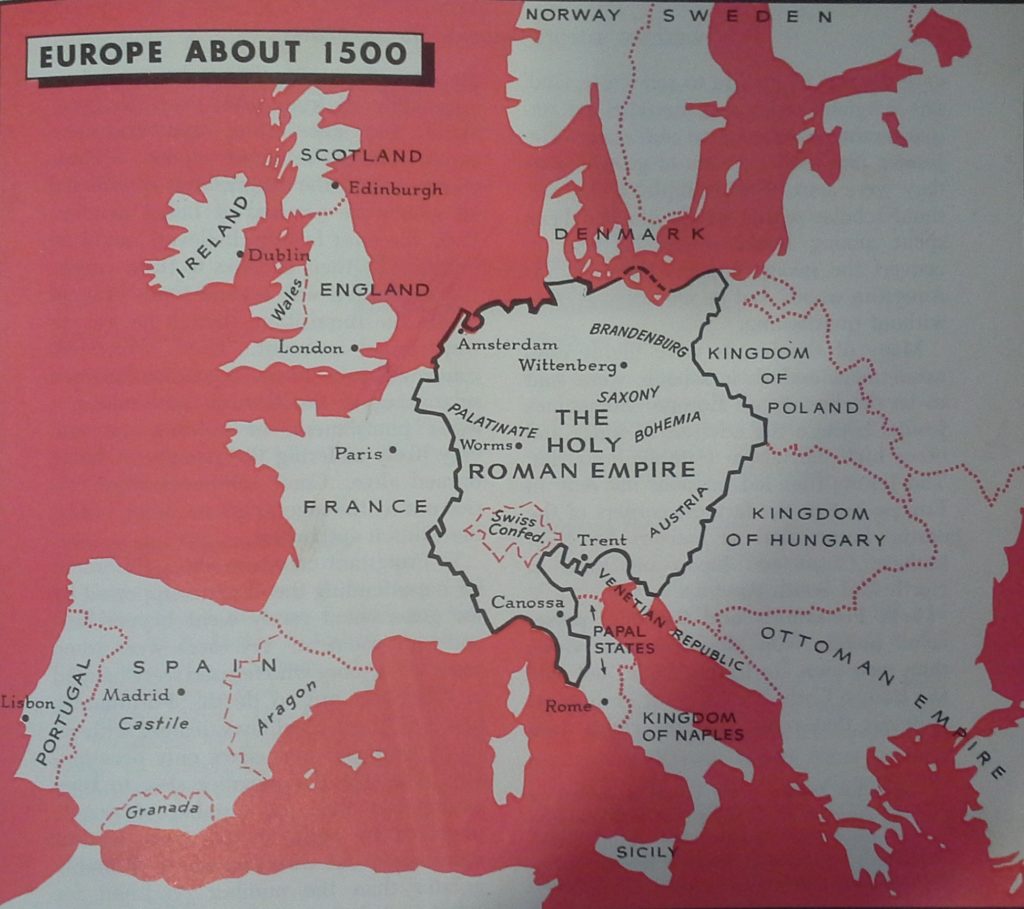
Roman Catholics had never been blind to abuses in the Church. A General Council of the Church held at Trent (1545 – 1563) improved church government. The Council also defined more clearly some of the beliefs of the Church which had been in doubt at the time Luther’s revolt began. Nearly all later Popes were devout and sincere. Attempts were made, especially in Germany, to get Lutherans and Catholics together into one church, but it was too late. The differences between the two, which were small when Luther began to preach reform, had widened so far that they could not be bridged.
Loyola formed the Society of Jesus. The missionary work of the Catholics was carried on chiefly by a new religious order called the Society of Jesus, or Jesuits. This was founded in the 1500’s by a brave Spanish soldier named Ignatius Loyola. Crippled by a wound, he decided to devote the rest of his life to service to God. His religious order was founded in unquestioning obedience to authority. The Jesuits, like soldiers, were to go wherever they were sent. For example, a shy and timid scholar whose whole life had been spent among books might be sent to convert the savage Indians in the North American woods, but he would go at once without questioning.
Many of the Jesuits were highly educated men and their schools were said to be the best in all Europe. Sometimes Jesuits became the advisers of kings and other high officiaIs in Catholic countries. The Jesuits founded missions not only in Europe but in the farthest corners of the earth. Some died as martyrs for their faith in China and Japan and some in North and South America.
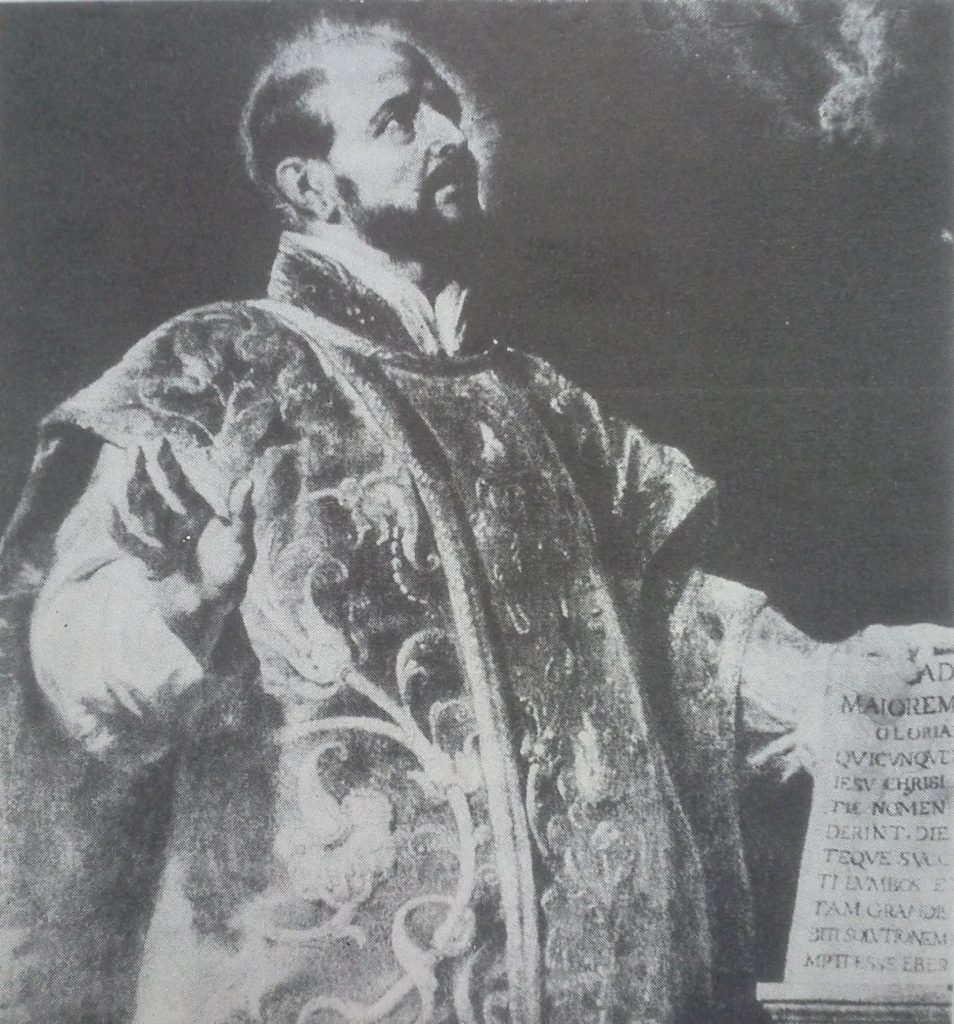
Both Protestants and Catholics persecuted people with other religious views than their own. In Luther’s time, not only the Roman Catholics but most Protestants believed that rulers had the right, even the duty, to punish those whose religious ideas differed from their own. In Italy, Spain and some other countries there were special religious courts. These courts, called the Inquisition, questioned all who were accused of being heretics. Even the most faithful believers might be reported by their enemies to these courts. Loyola himself was several times brought before the Inquisition, though he was always found innocent. Those who were convicted were given the choice between submitting to the Church and taking a lesser punishment, or holding out and very likely suffering the penalty of being burned alive. Court sentences were carried out by the regular government, not by the Church authorities.
In Protestant countries the punishment for not attending the church supported by the government rarely went beyond fine and imprisonment. Yet there were some cases when those who refused were hanged or otherwise put to death. Fortunately, however, these cruel laws dealing with religion were put into effect only occasionally. We should remember also, to keep us humble, that the number of people punished by dictators for their political opinions in our own century is probably greater than the number punished for religious beliefs in any past century.
By the 1500’s, then, profound changes had taken place in the way of life which was common throughout Europe during the Middle Ages. Separate nations were becoming stronger under the rule of kings. These monarchs not only gained the upper hand over feudal nobles but questioned the powers and privileges long claimed by the Church. The Renaissance was producing new ideas. All these forces helped to break down the unity of the Catholic Church and aided the spread of Protestantism, Europe was emerging into a new era.
